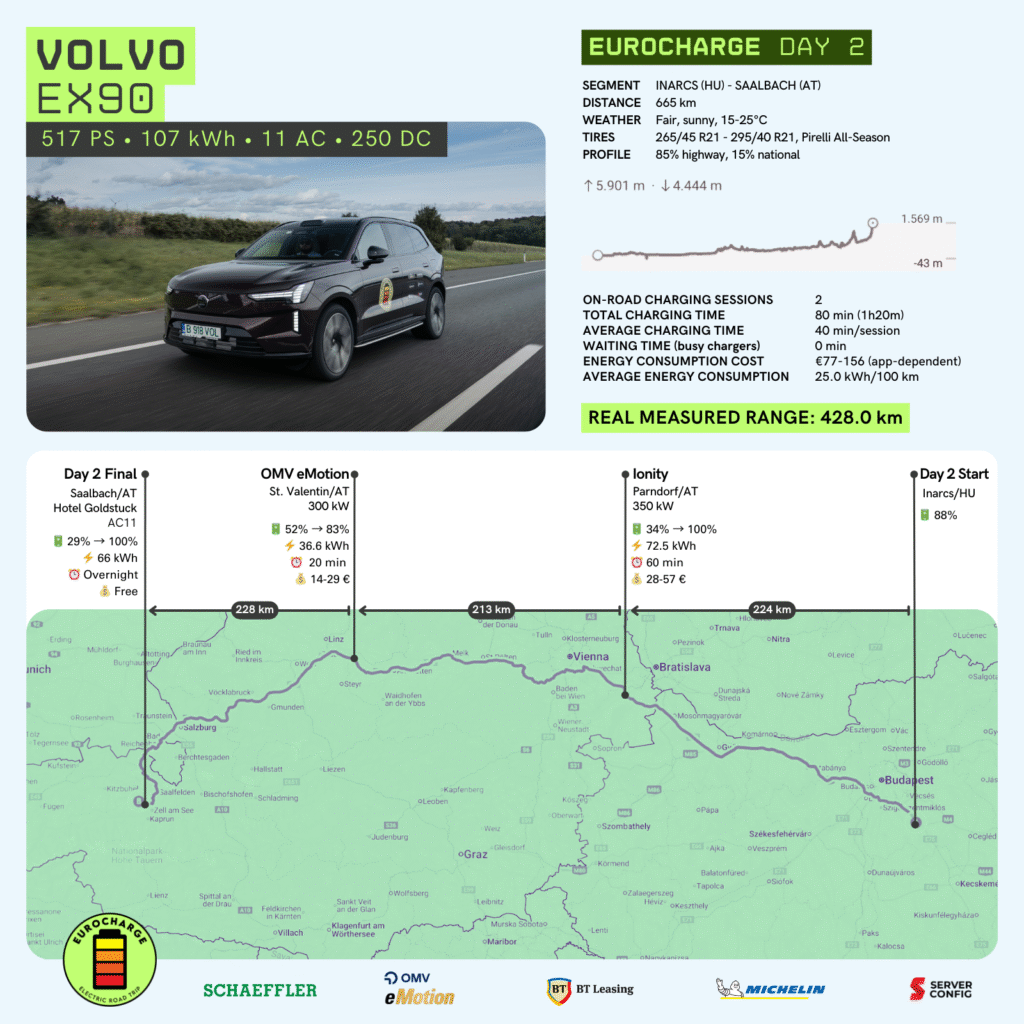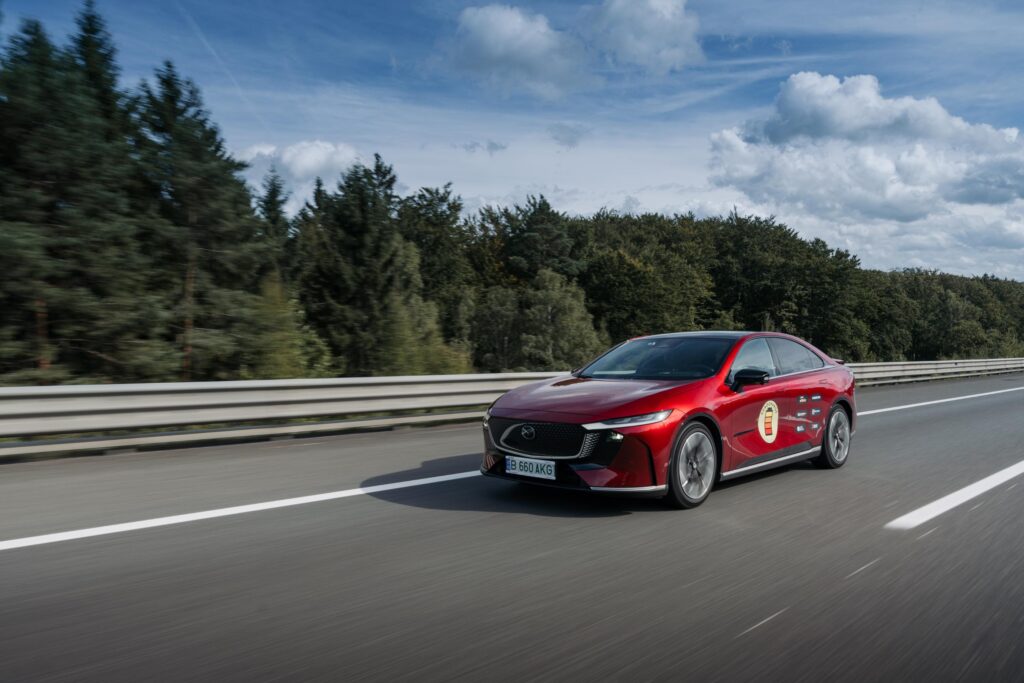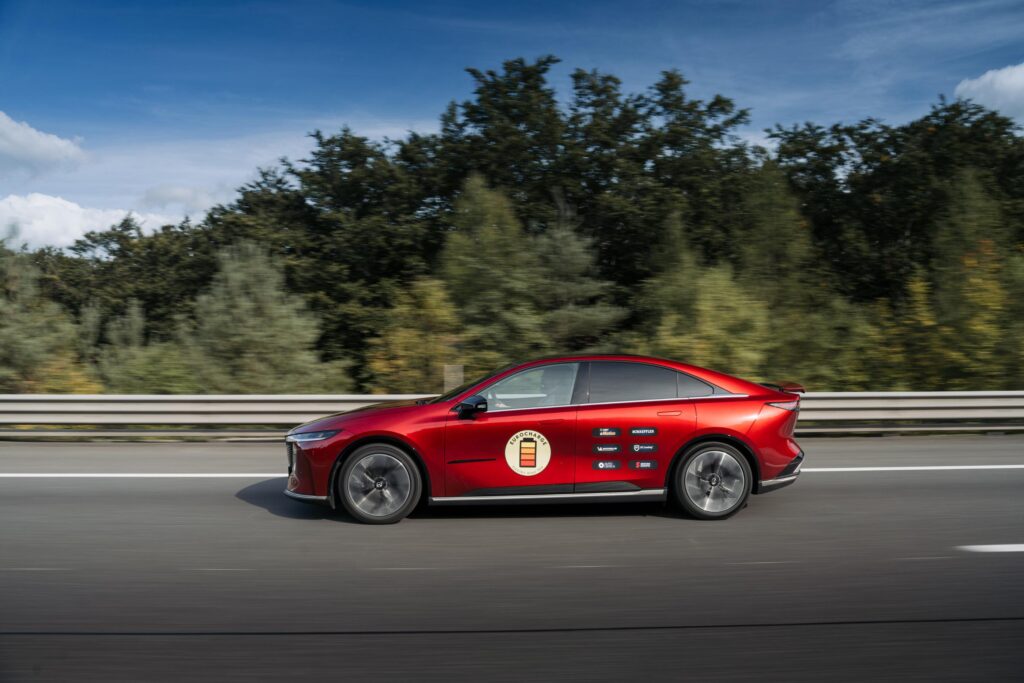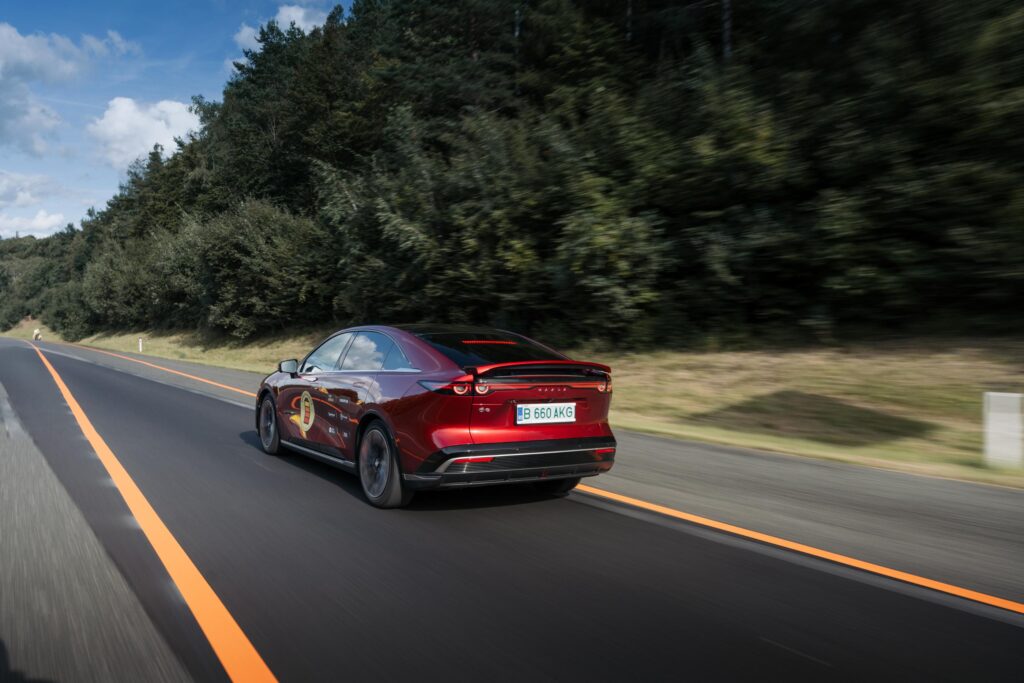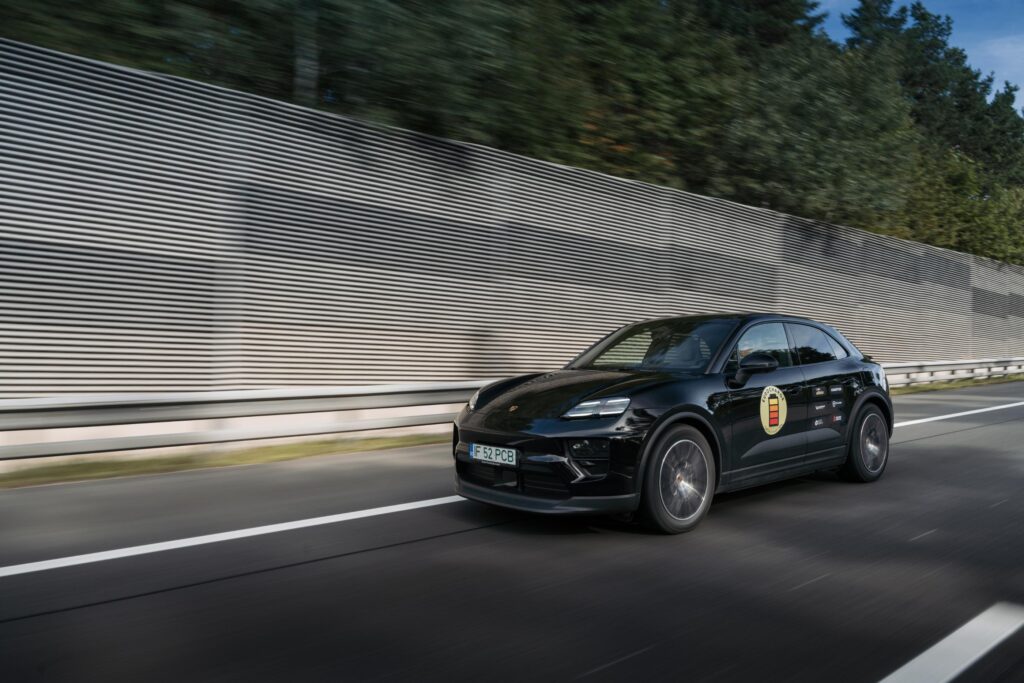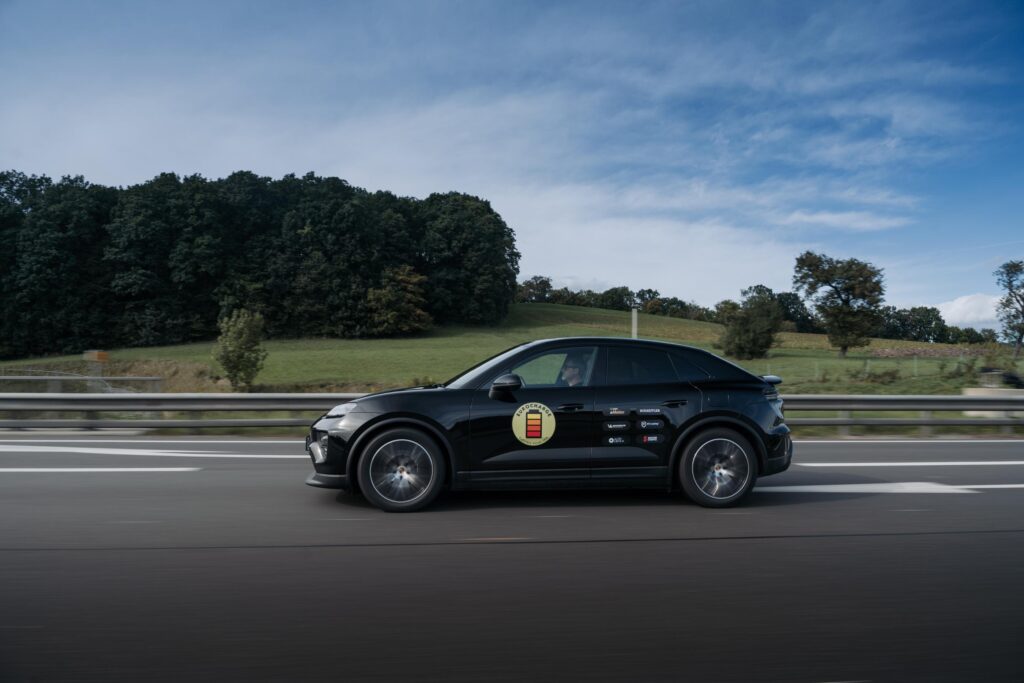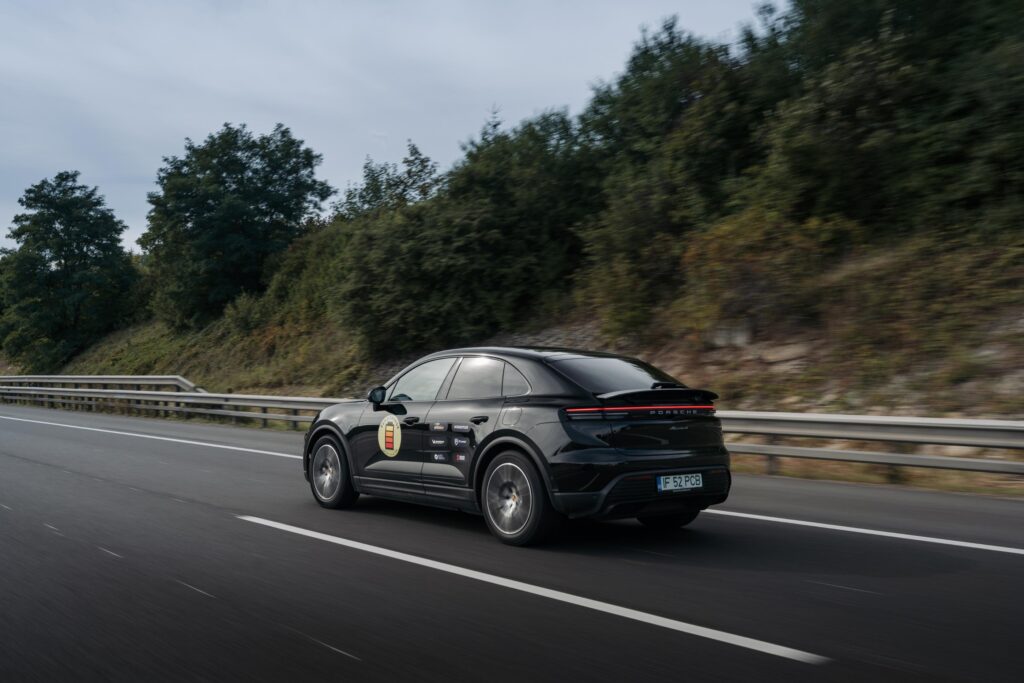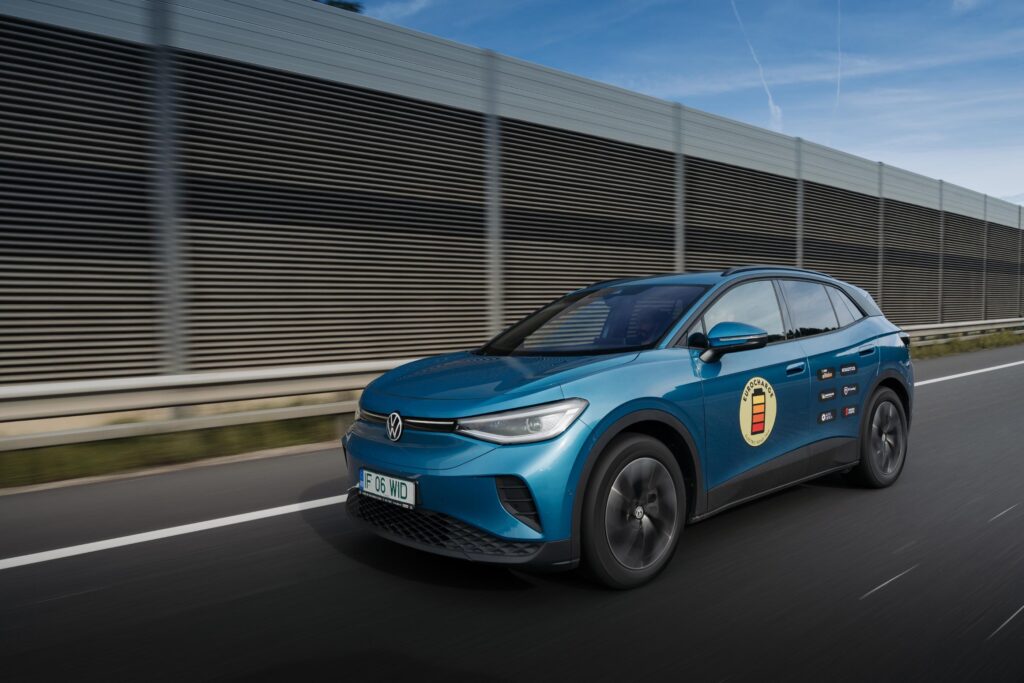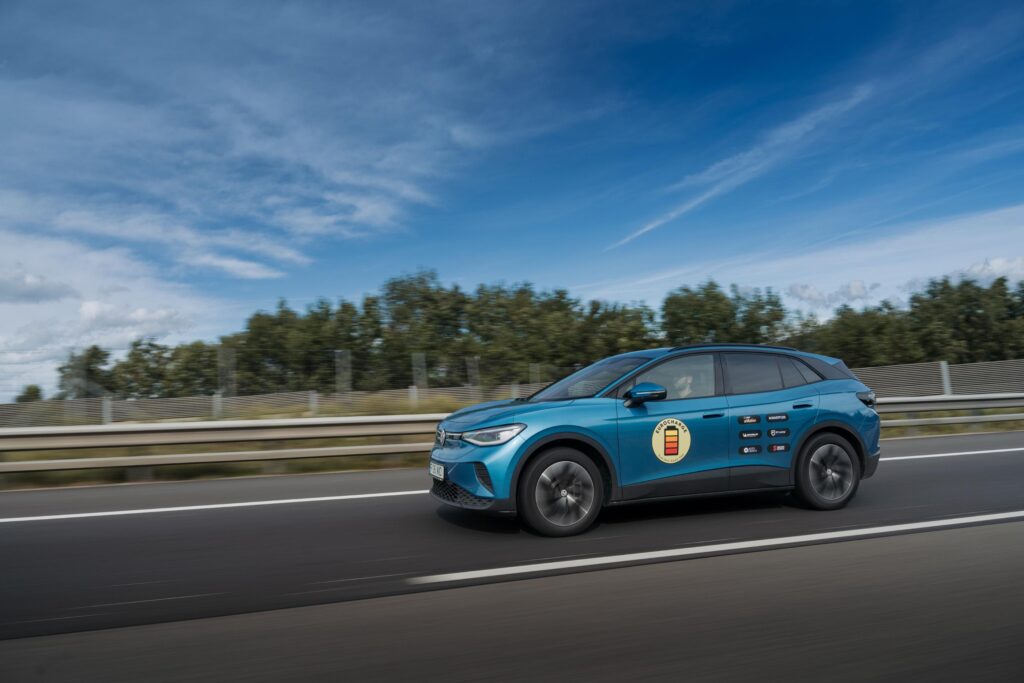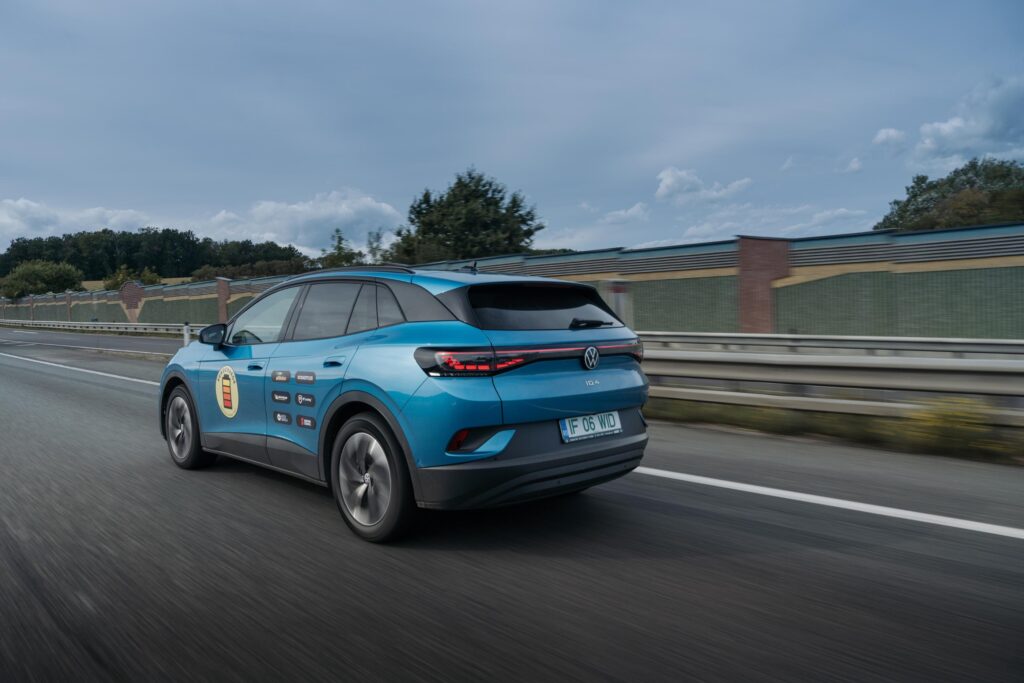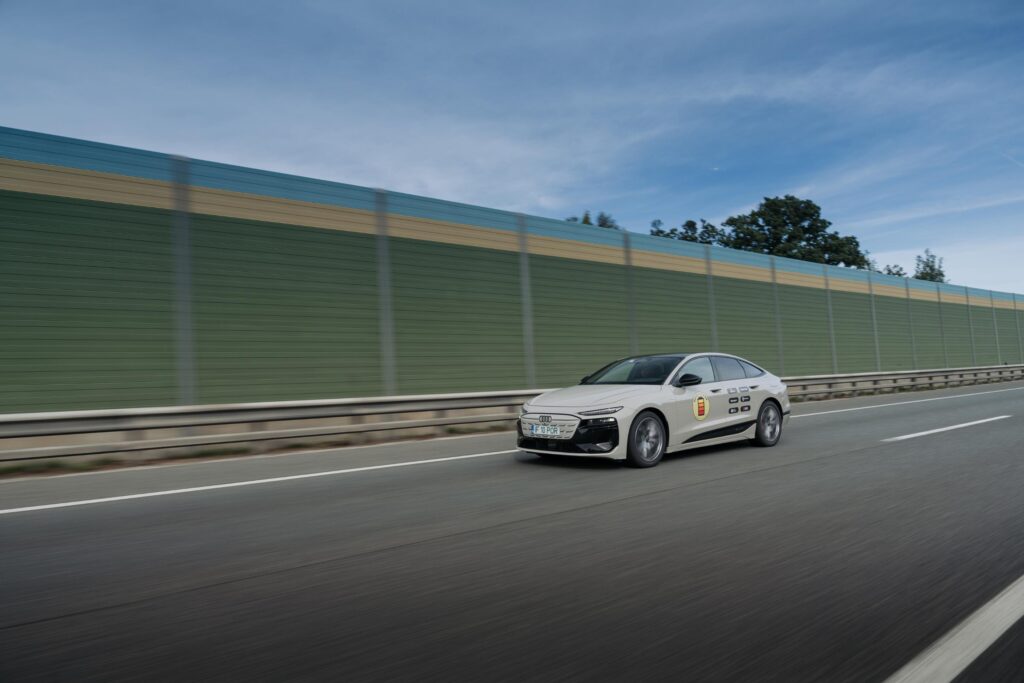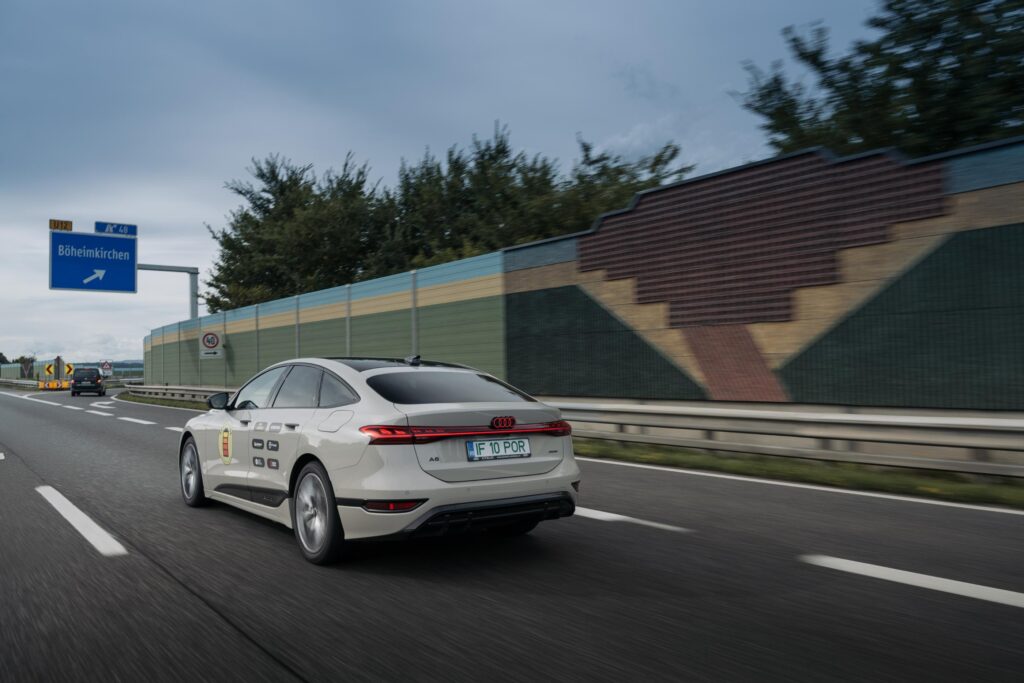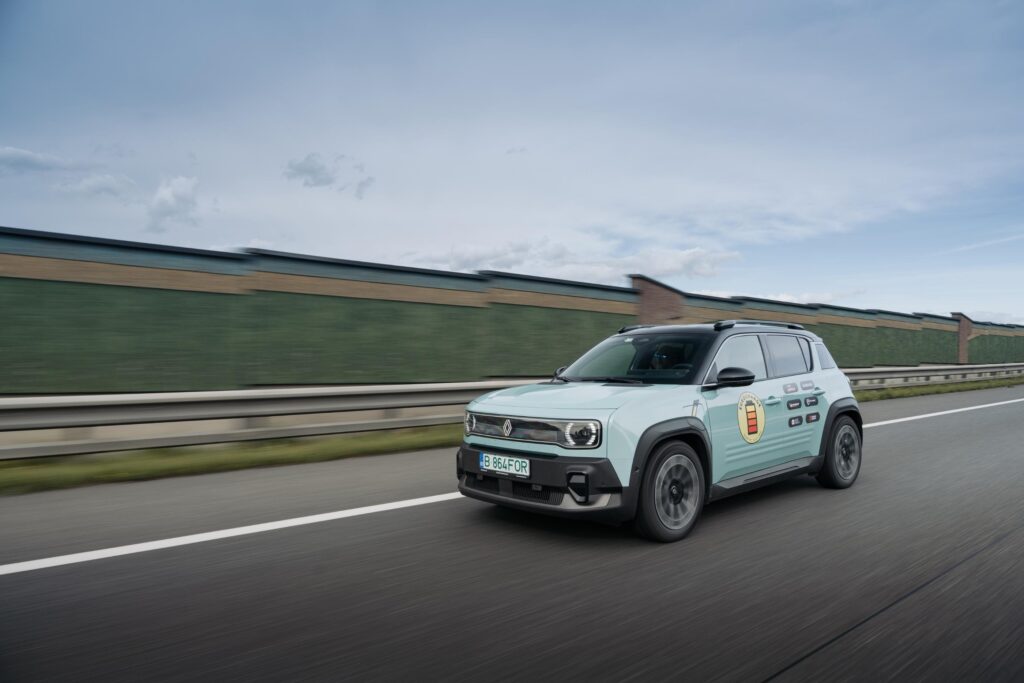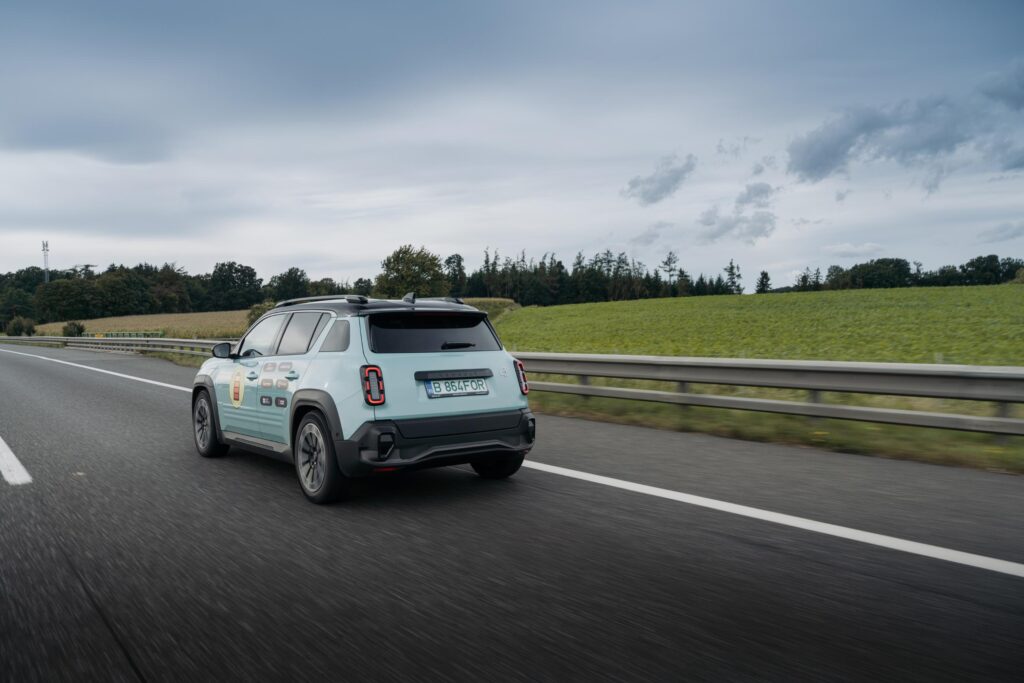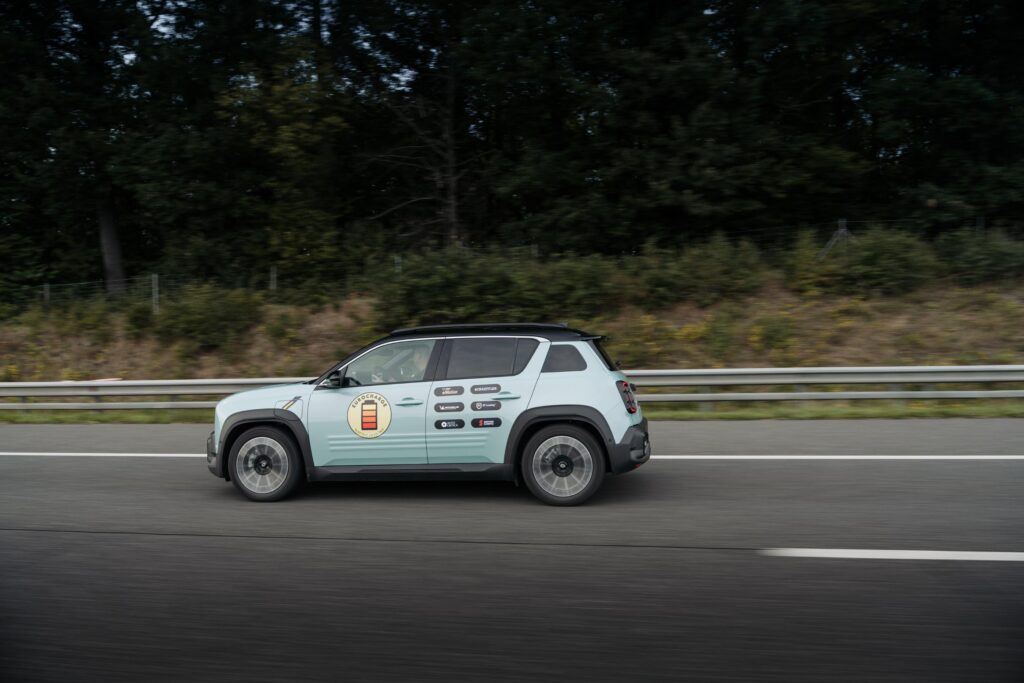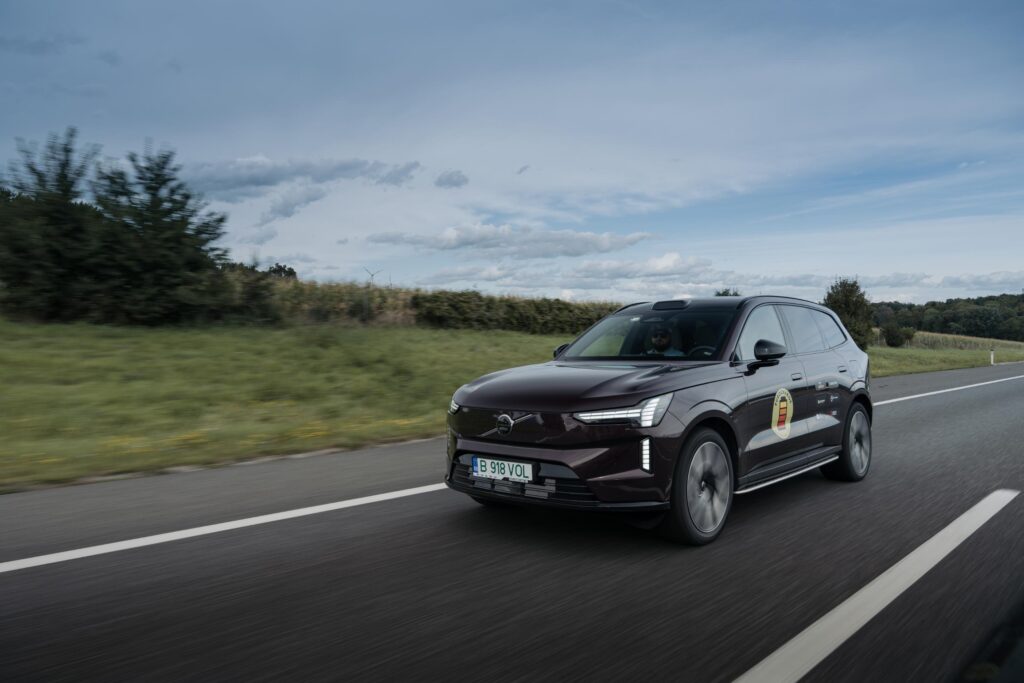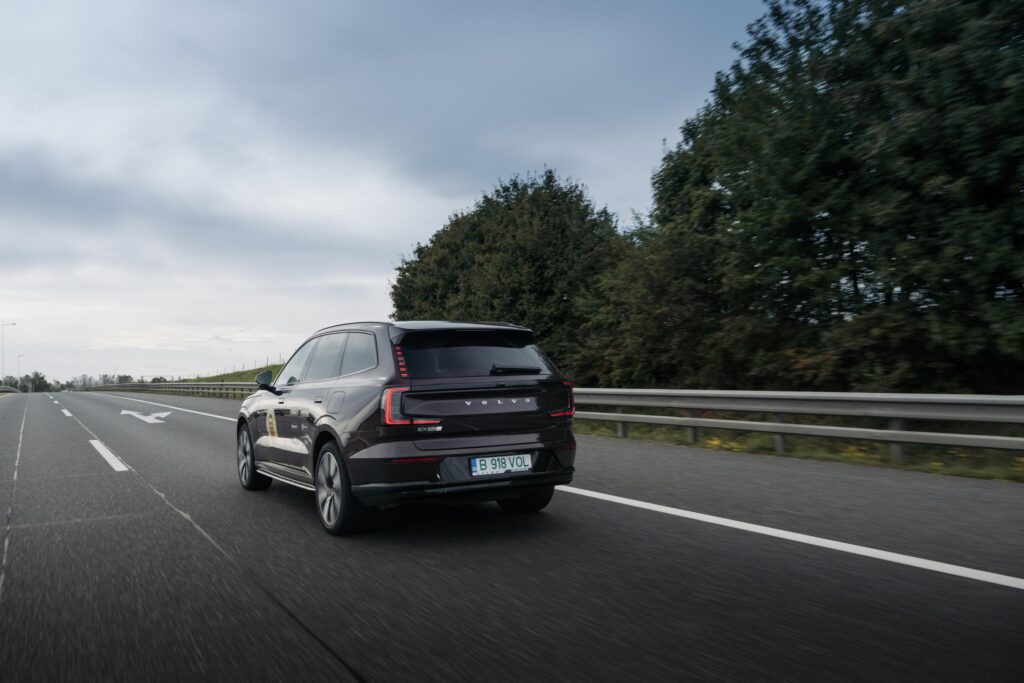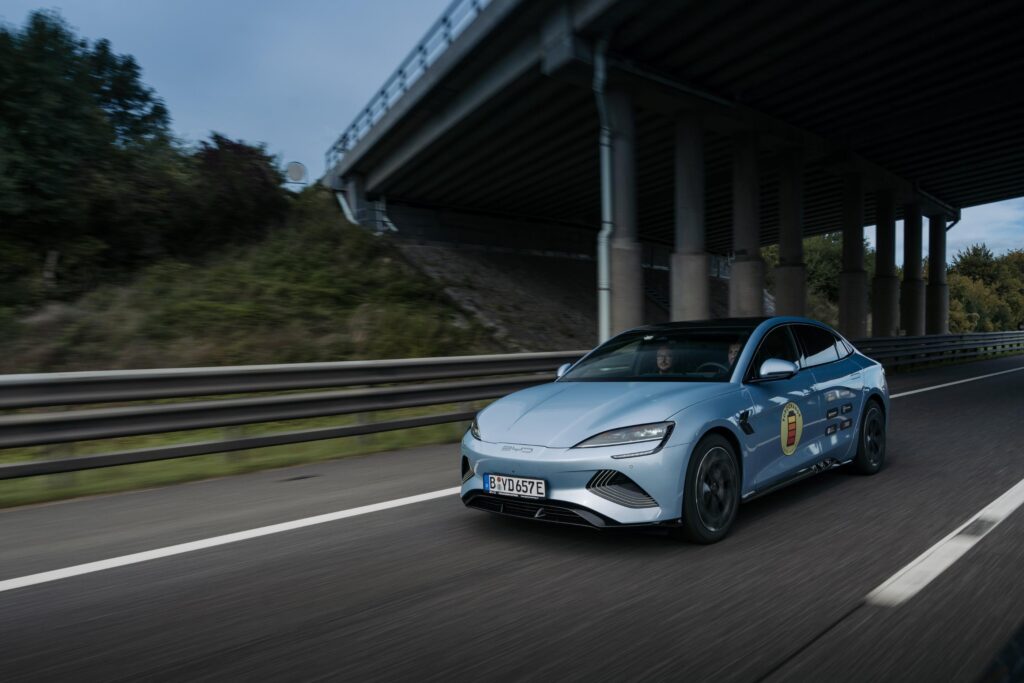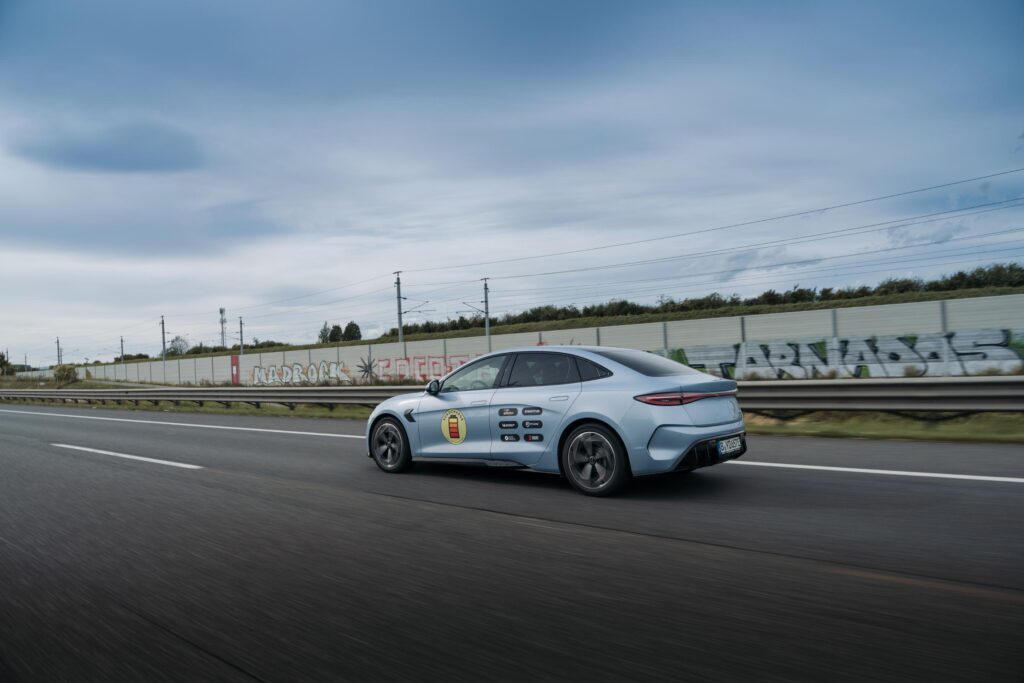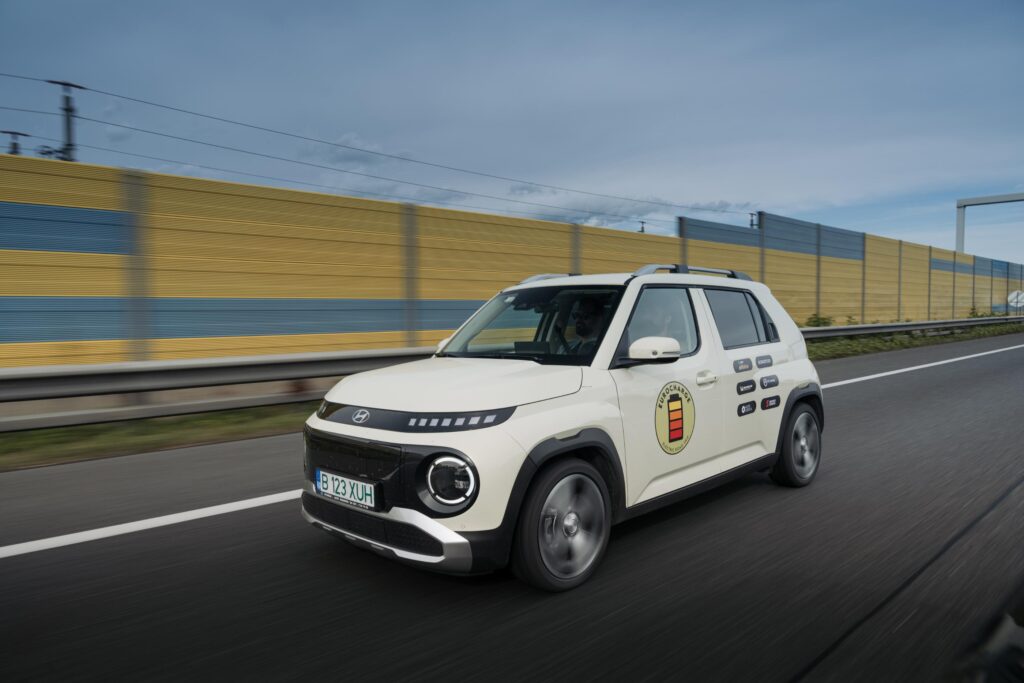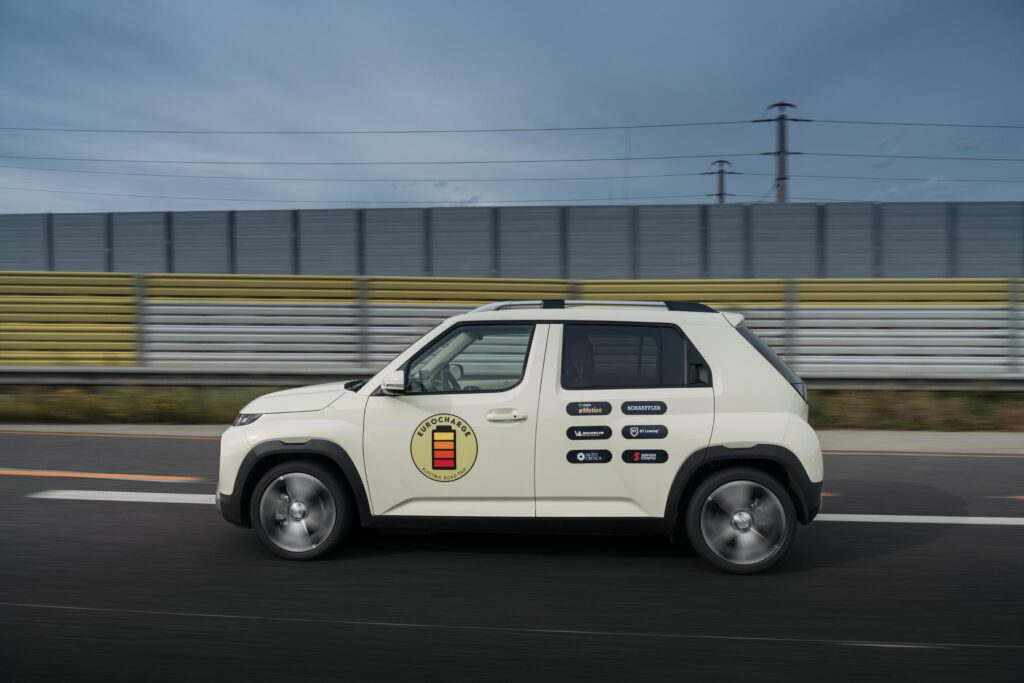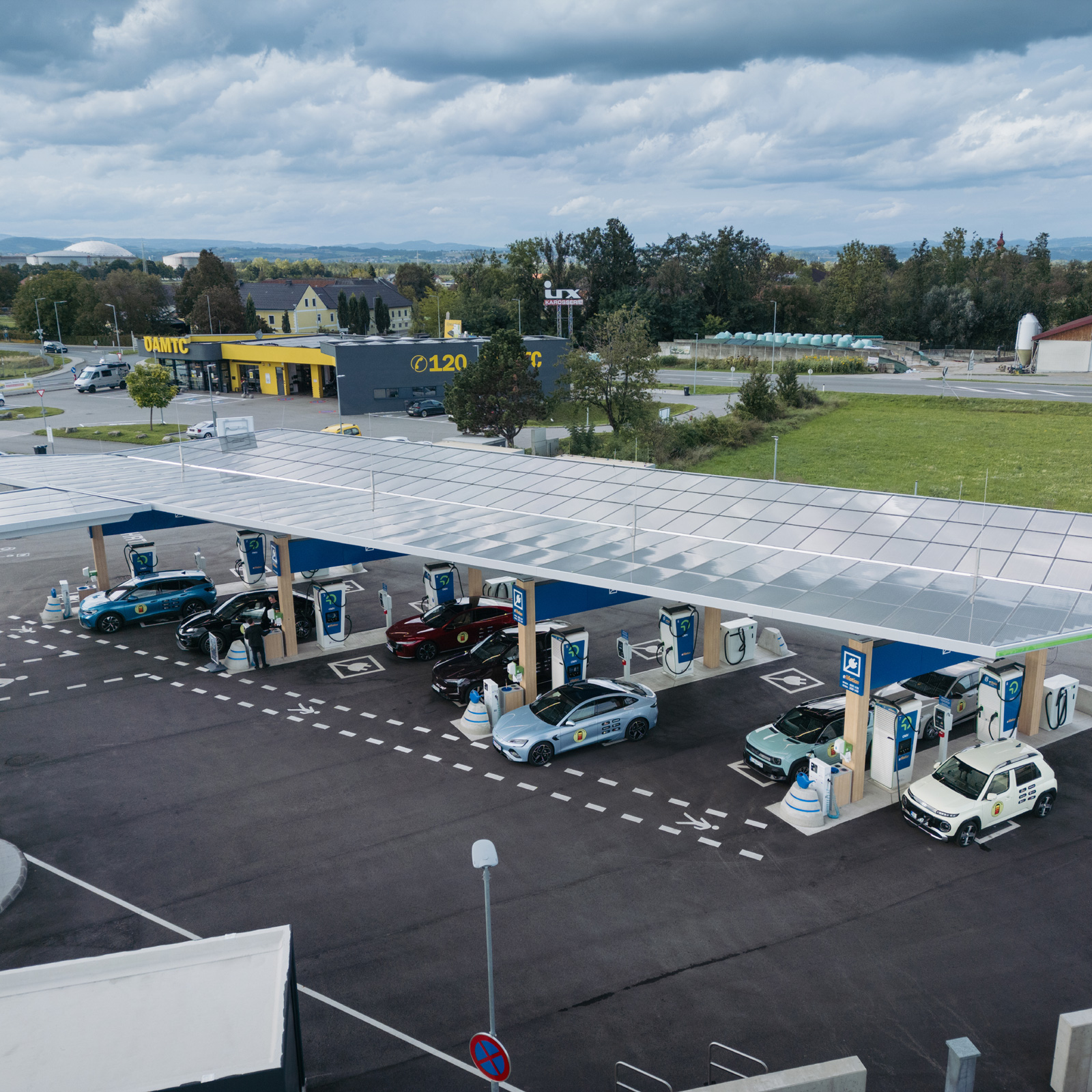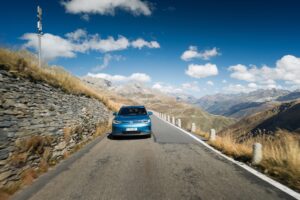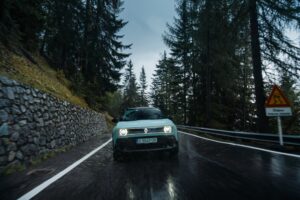Still thinking about crossing the Transfăgărășan on the first day of EUROCHARGE by Schaeffler, we left Flow Hotel in the Hungarian town of Inarcs and before long, a light fall rain startled the windshield wipers on our electric cars. Another day of mostly highway driving was waiting ahead of us (85% of the route, to be precise), but the stops we made on our way to the Alps offered a few moments of reflection, for several reasons.
After crossing the border into Austria, we stopped in Parndorf. The main goal? A well-deserved lunch break. And while people were eating Italian food at L’Osteria Parndorf, some electric cars were being replenished with fresh electrons at the OMV eMotion charging stations located right in the outlet’s parking lot.

In fact, there are two fast-charging, 300-kW stations and six 50-kW ones. In other words, the perfect place to charge an electric car during lunch or, why not, as part of a complete outlet shopping experience.
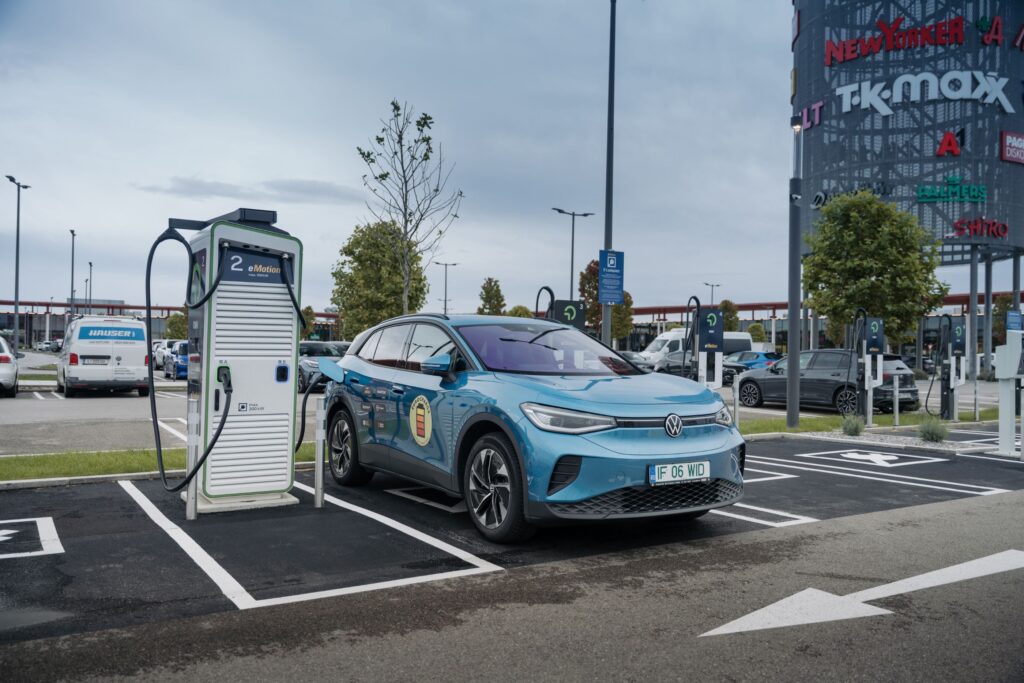
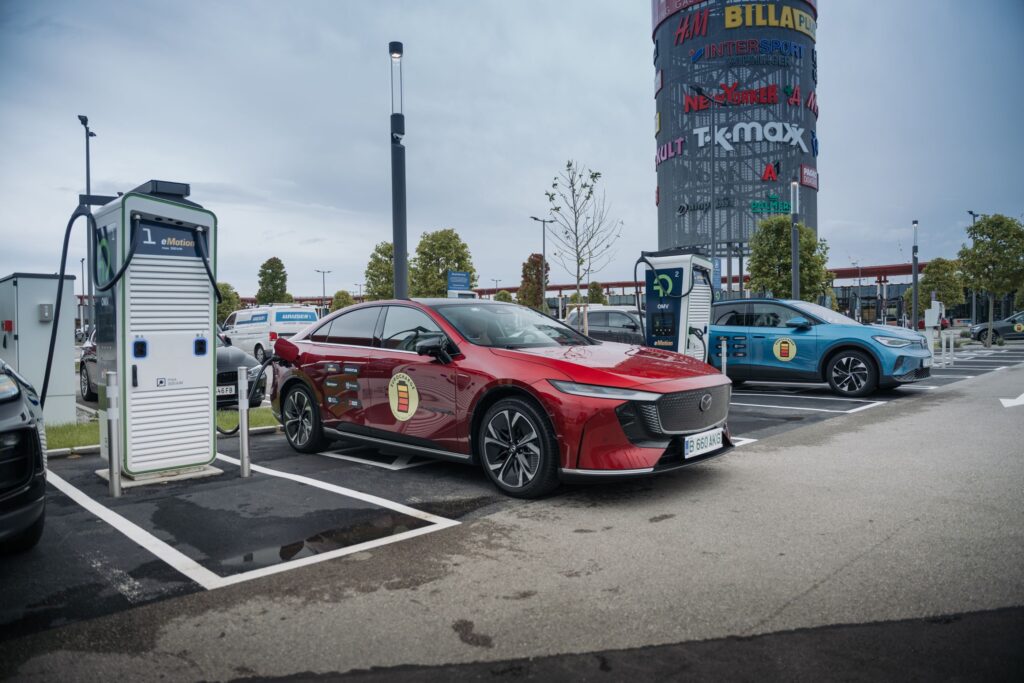

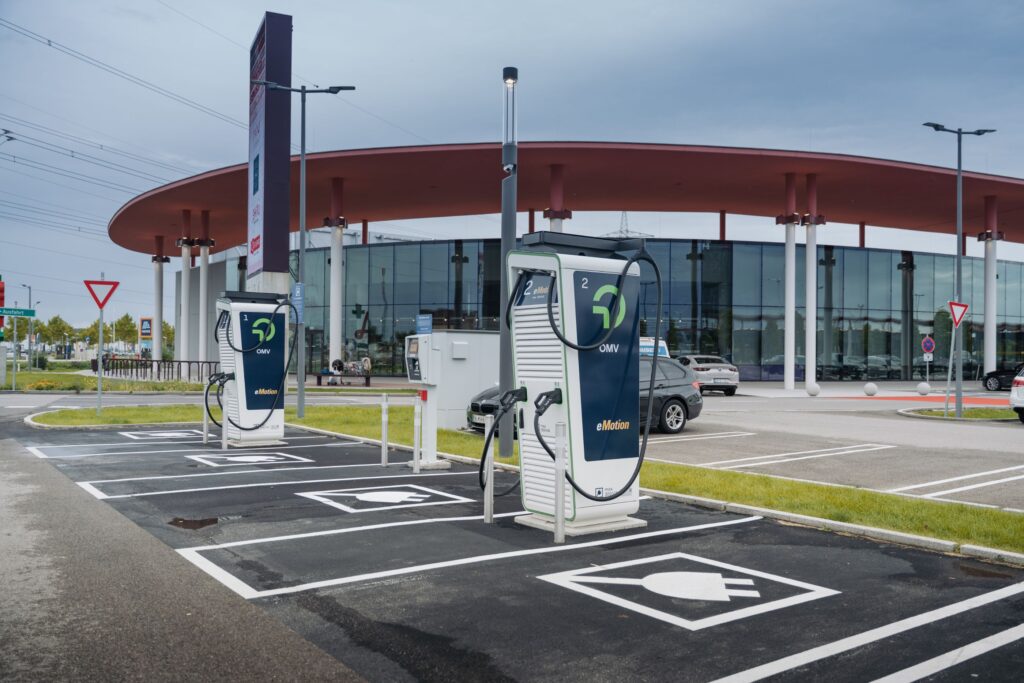

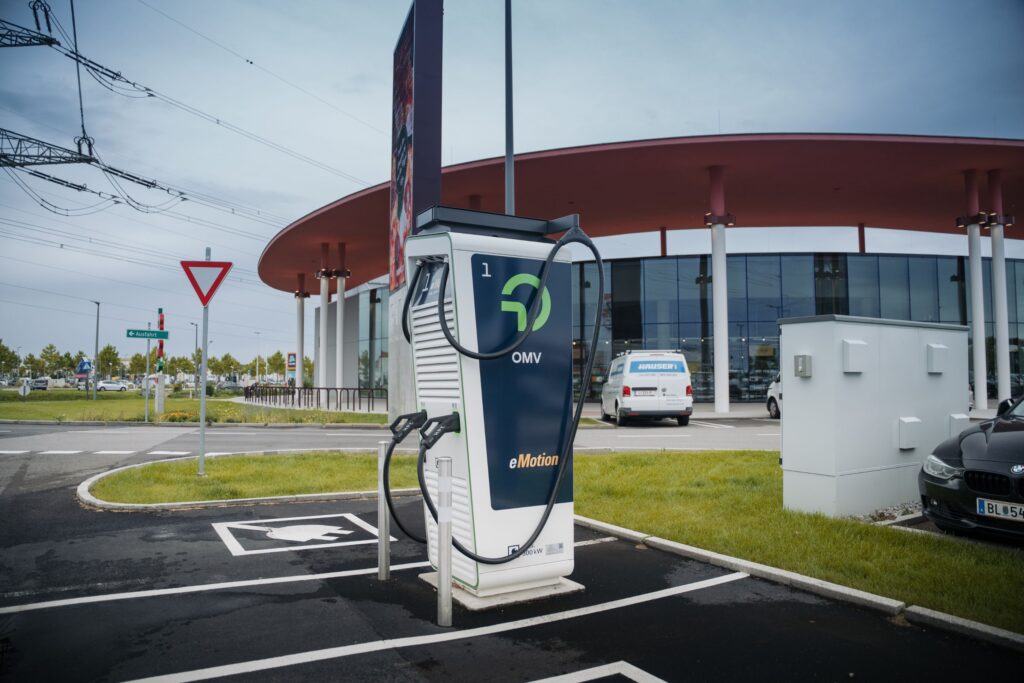
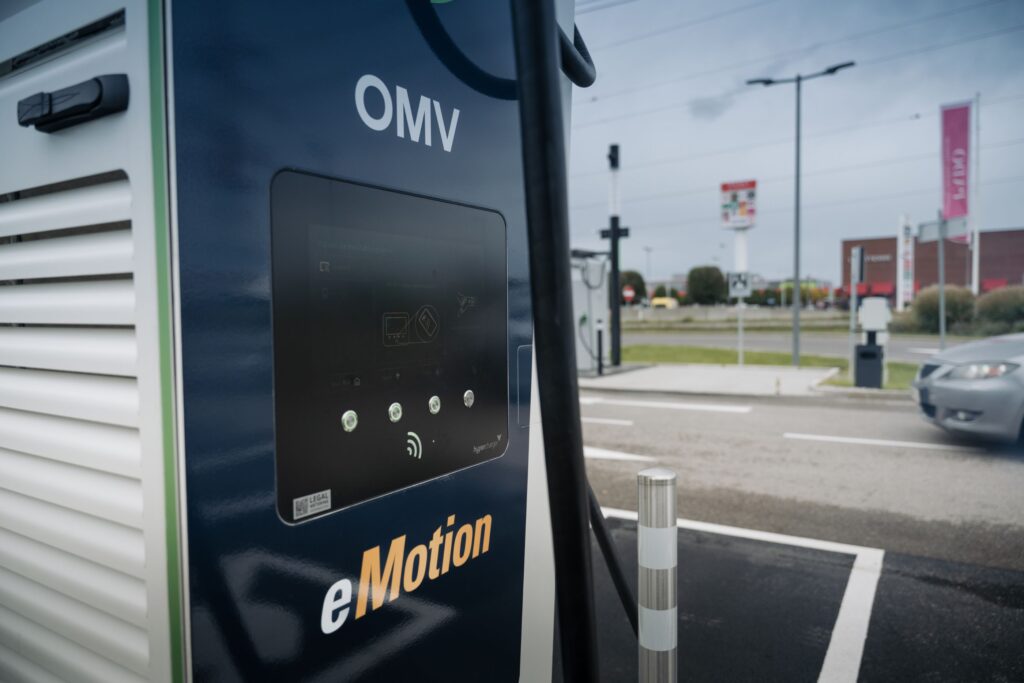
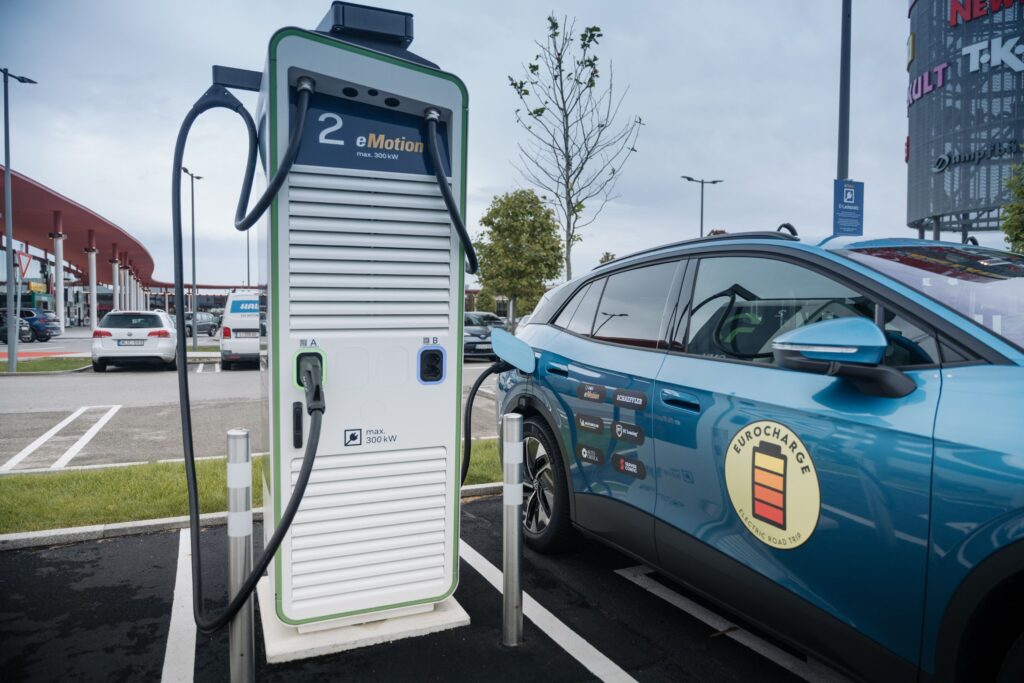
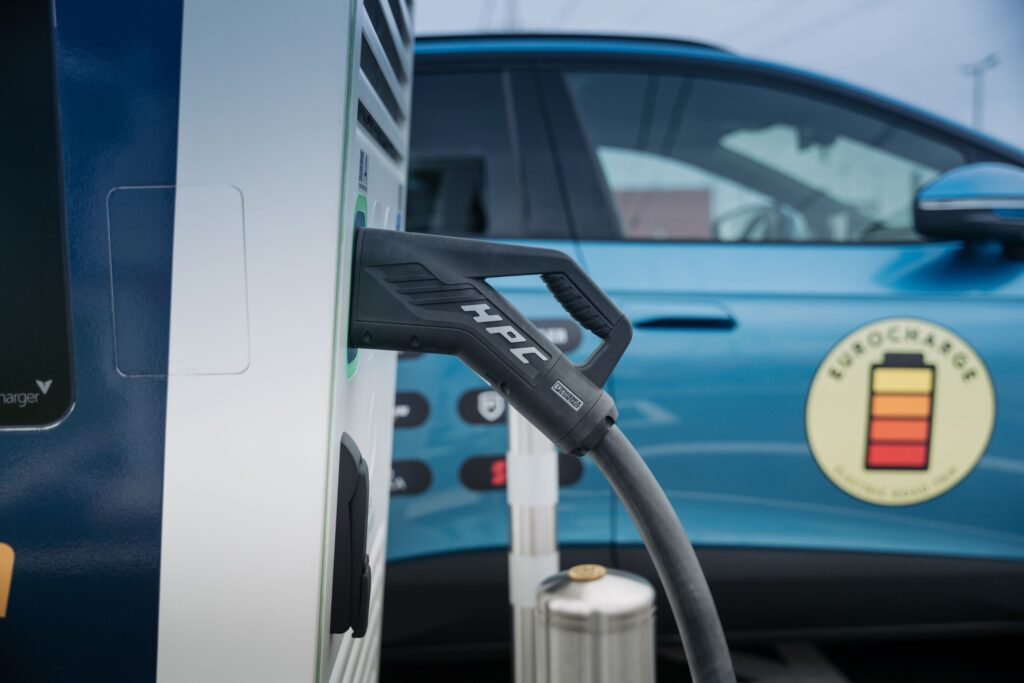
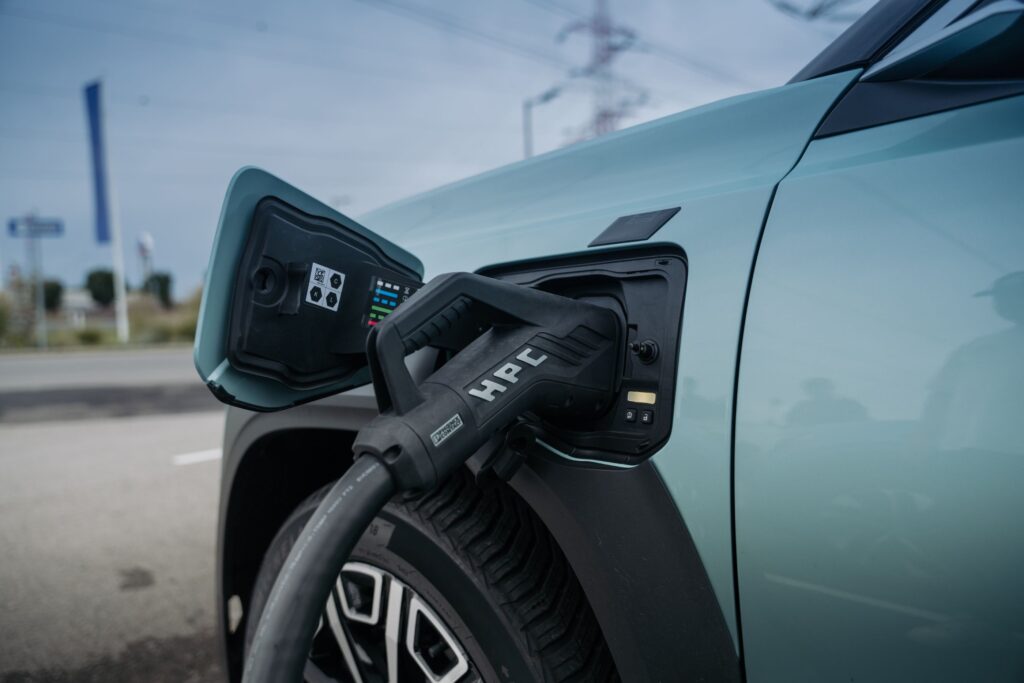
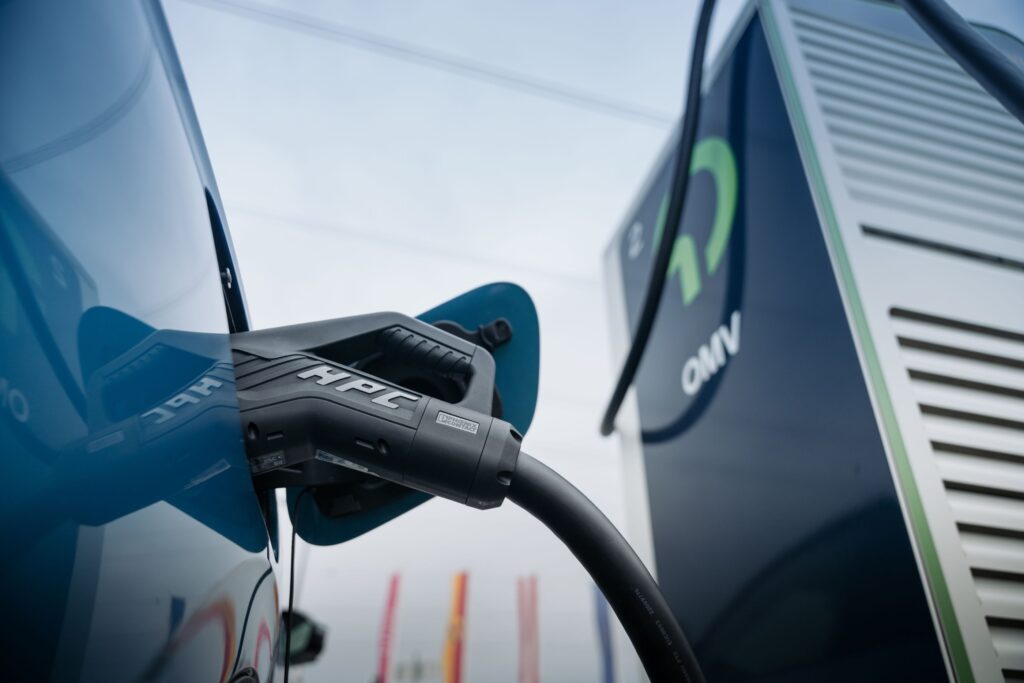
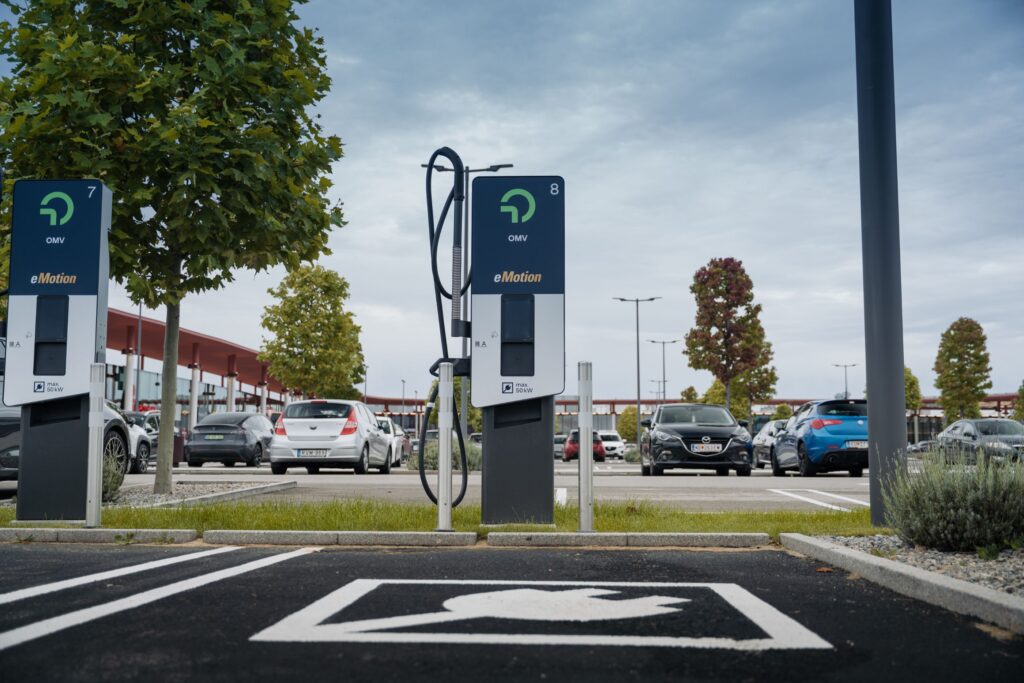
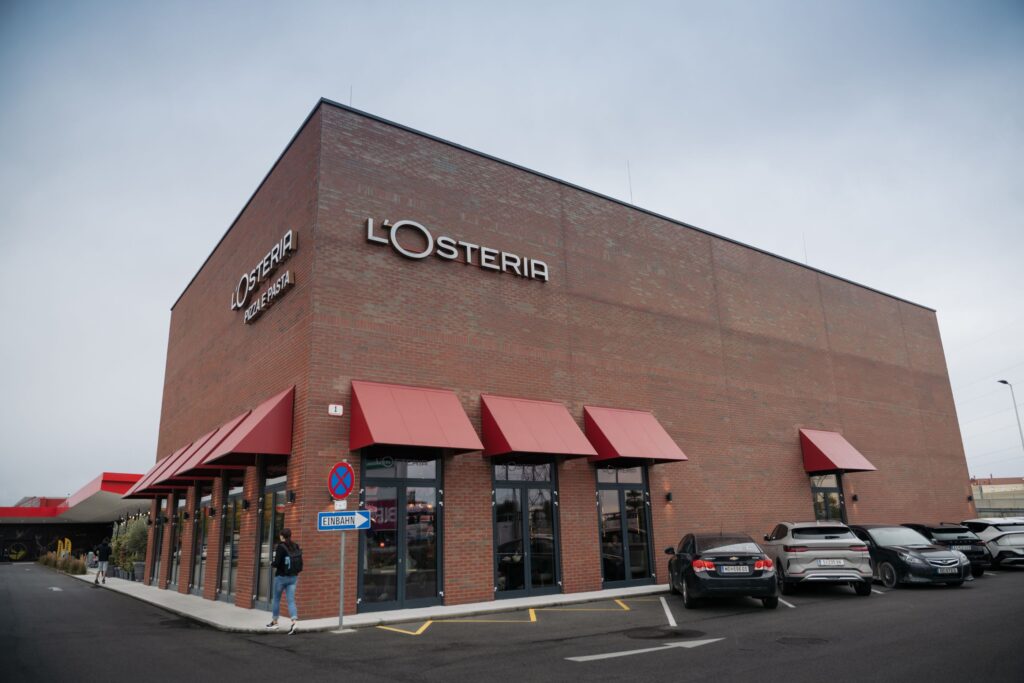
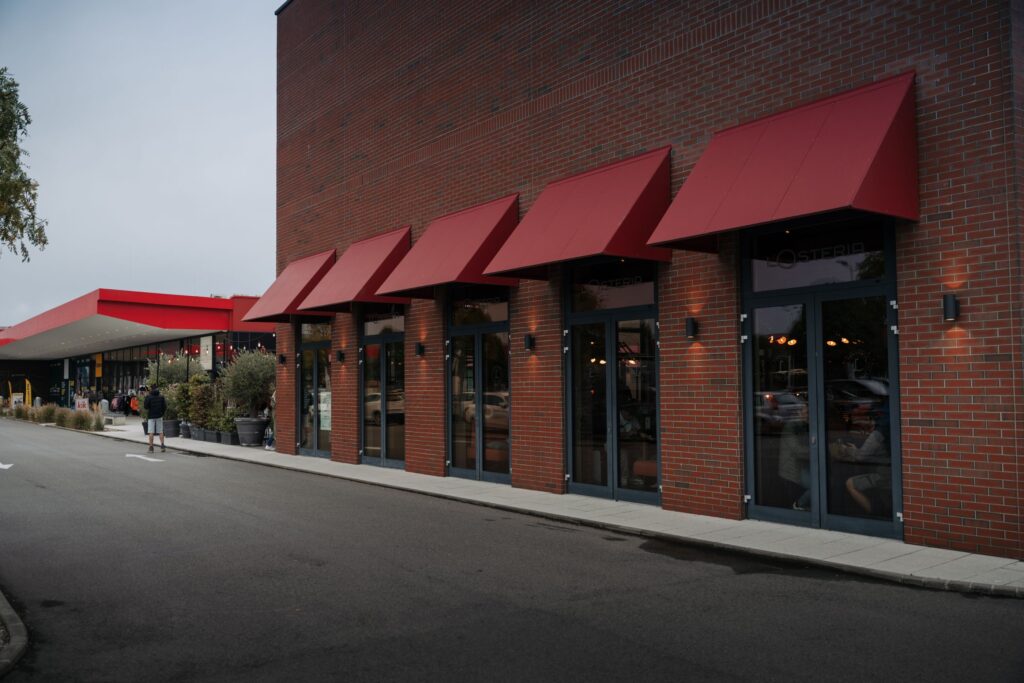

All Under One Roof
Alland is a town of less than 3,000 inhabitants located only 20 kilometers away from Vienna. Documented as early as the 8th century, Alland is today located next to the A21 highway, which was our partner on the way to our final destination of the day.
Why did I choose to describe Alland? Well, on our way to the Alps, we discovered an OMV hub where electric cars are charged under the same roof as ICE cars. You read that right, at OMV Alland the charging stations and fuel pumps are under the same roof. In all likelihood, such rare examples of integrating two seemingly completely different technologies for the automotive industry will become increasingly common in the future.


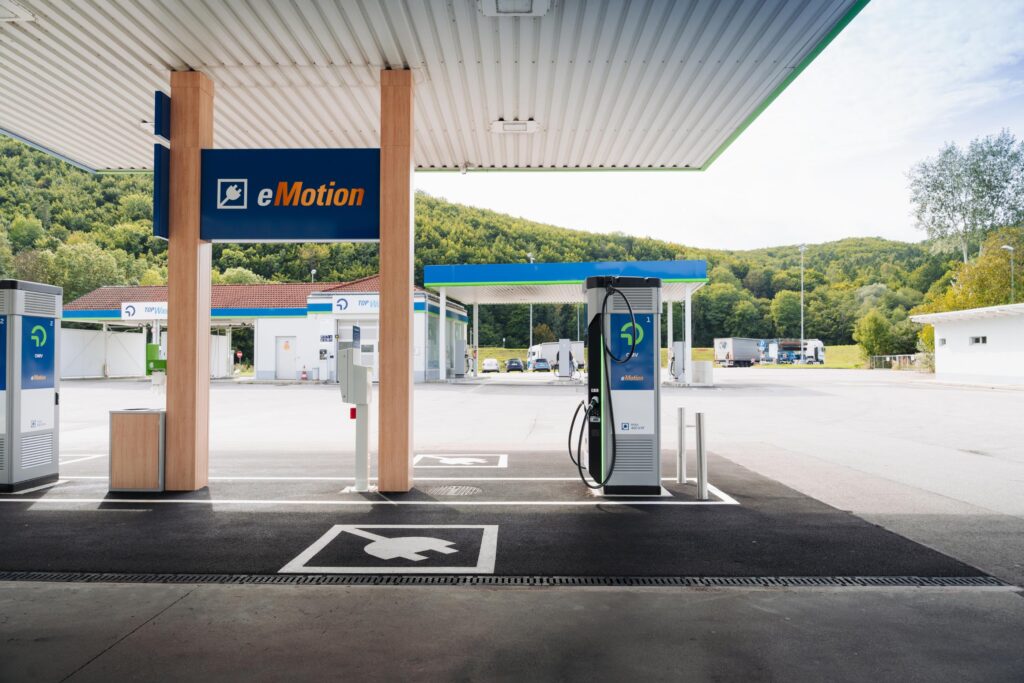

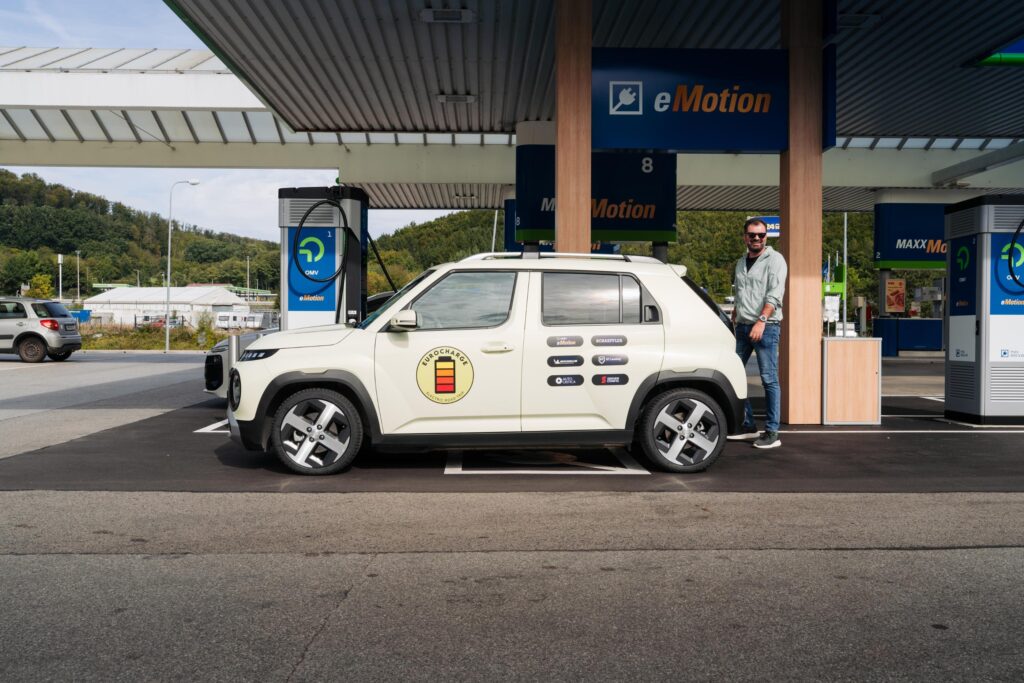
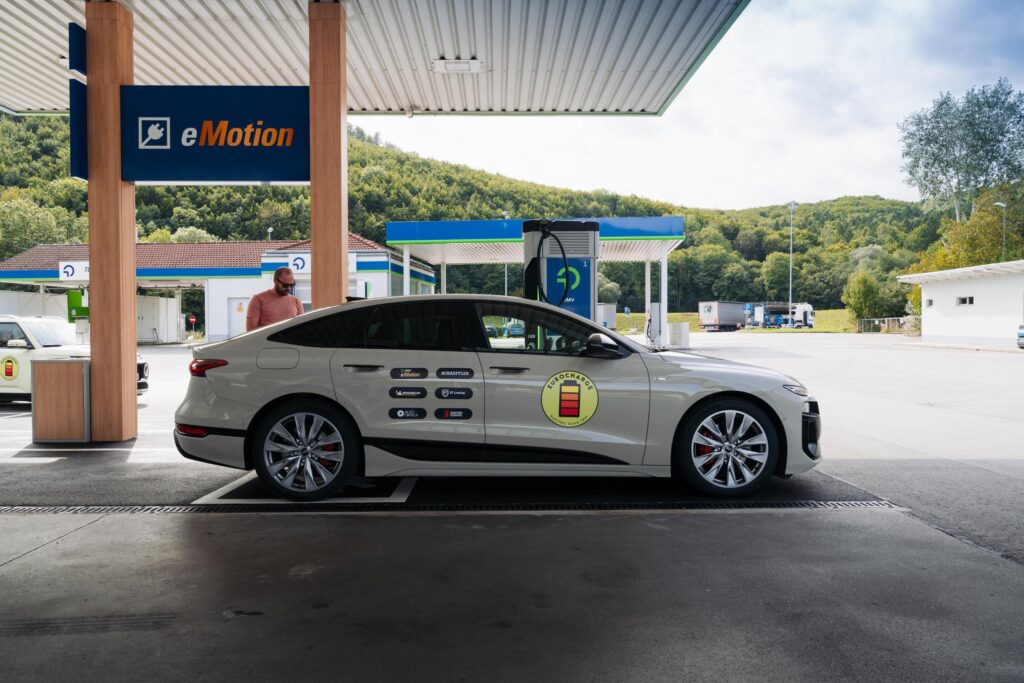
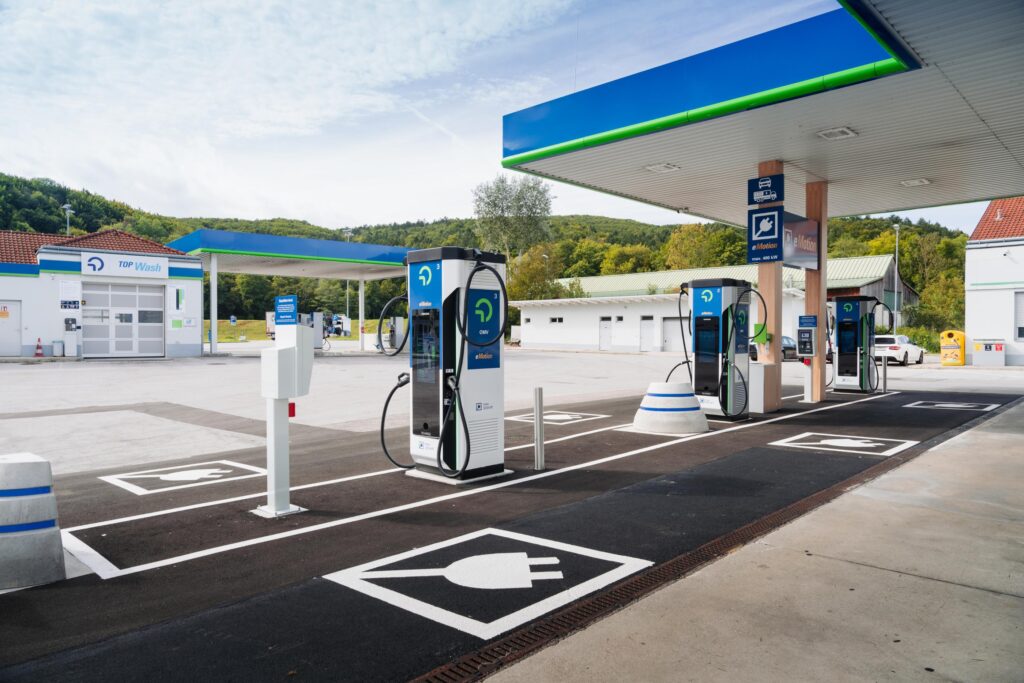

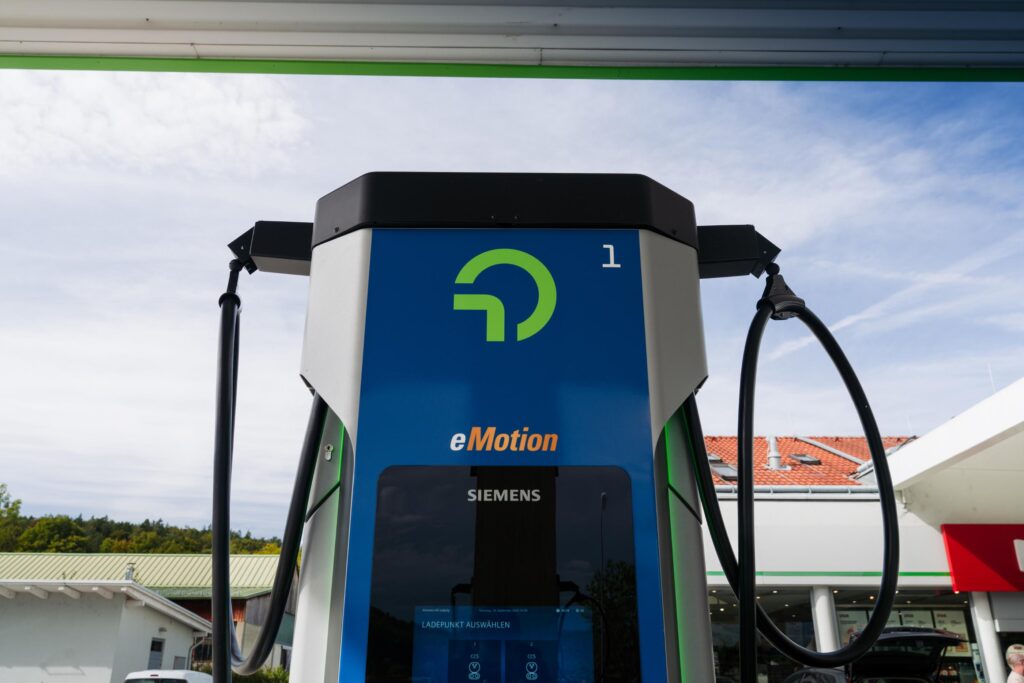
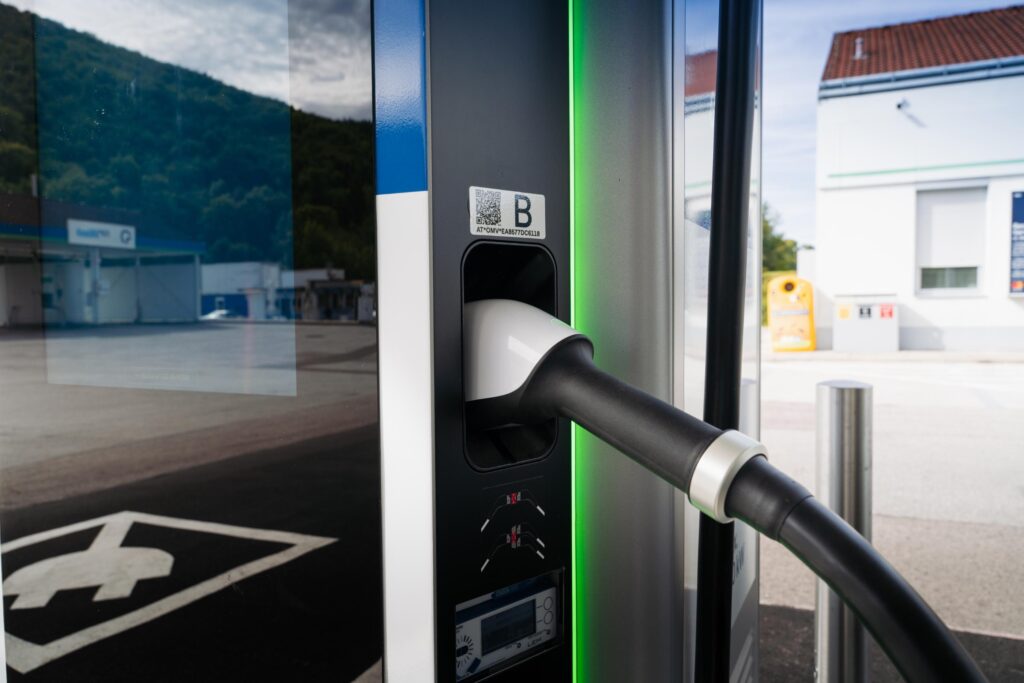
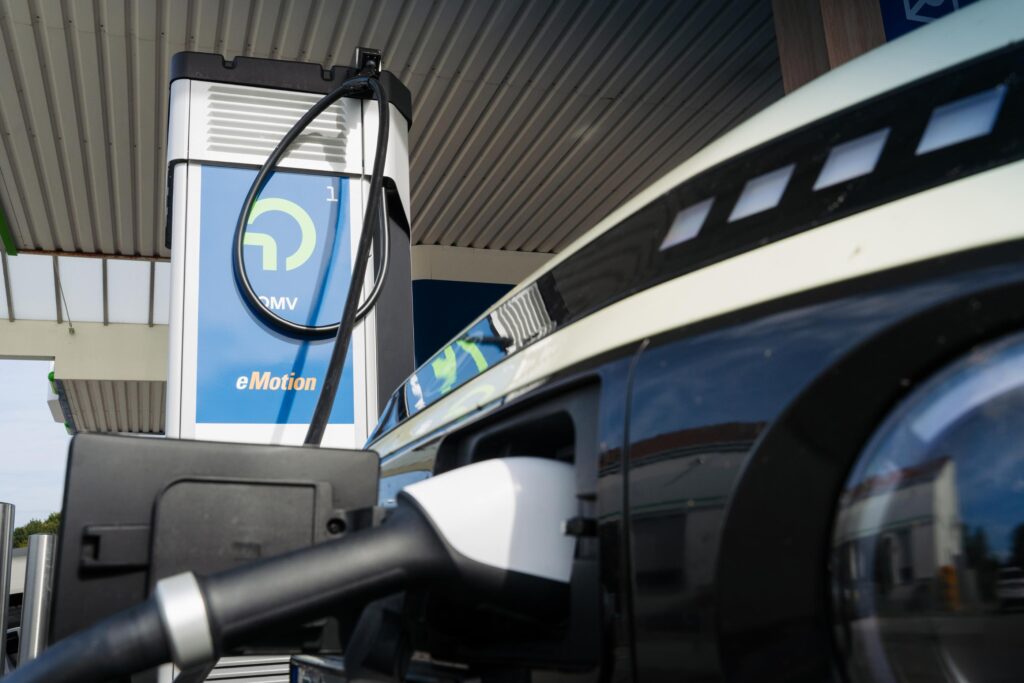
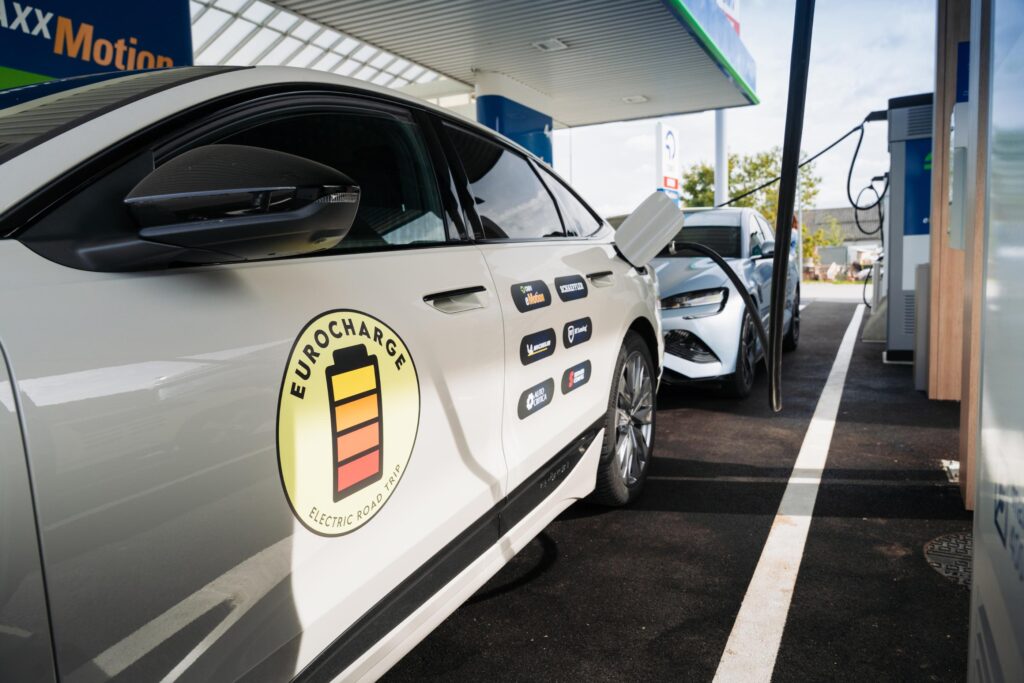
And that’s not all, because the 400-kW eMotion charging stations can also “plug in” electric trucks. Coincidentally, a Mercedes-Benz eActros electric truck was parked at a charging station next to the small Hyundai Inster during our visit. What are the odds, right?
The images look like something out of a science-fiction movie, but they’re as real as it: a 46-kWh battery electric car built for the city charging side by side to a 600-kWh battery electric truck that supports up to 400-kW charging.


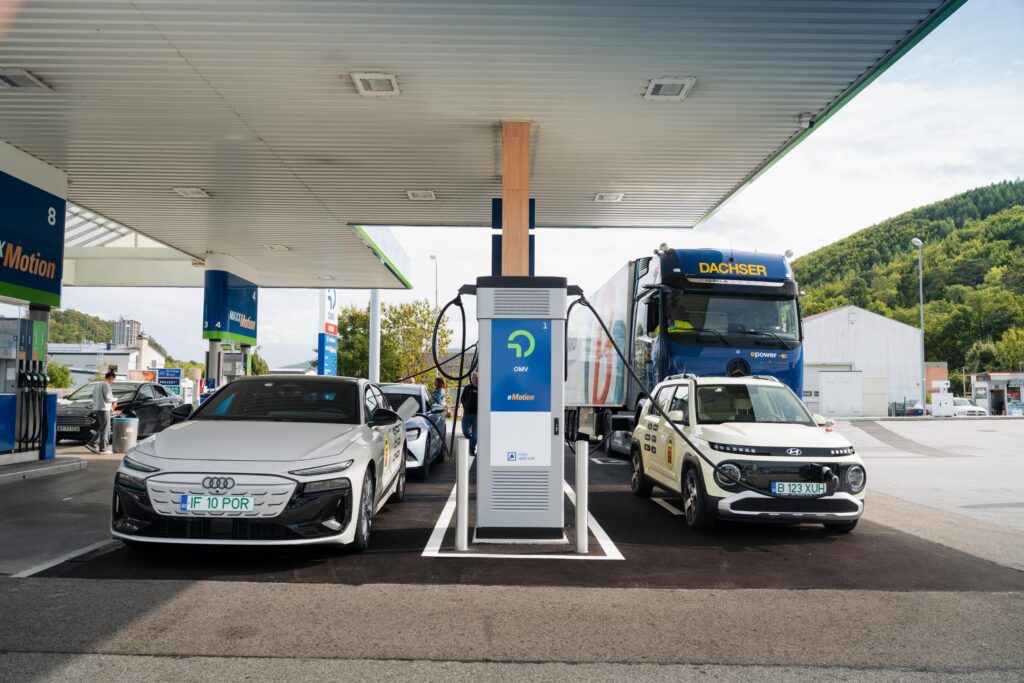


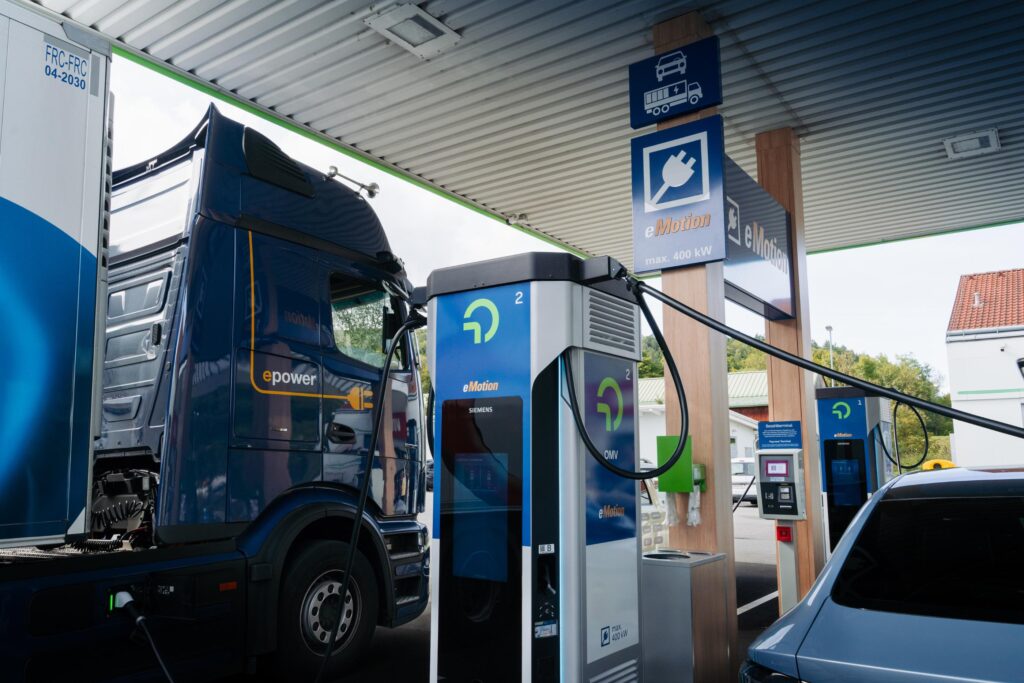
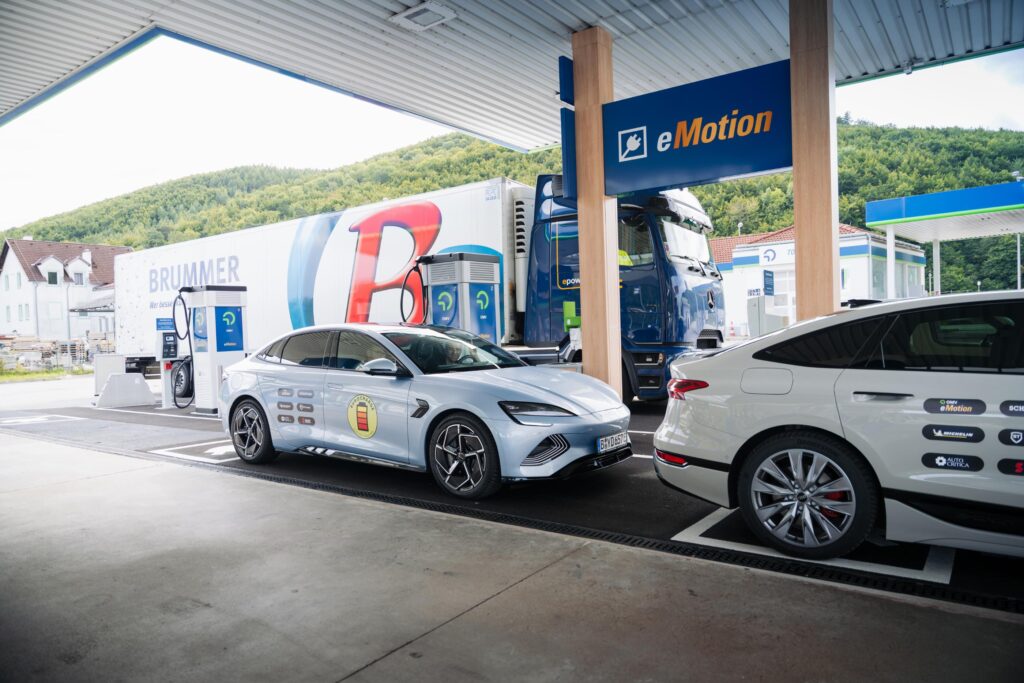
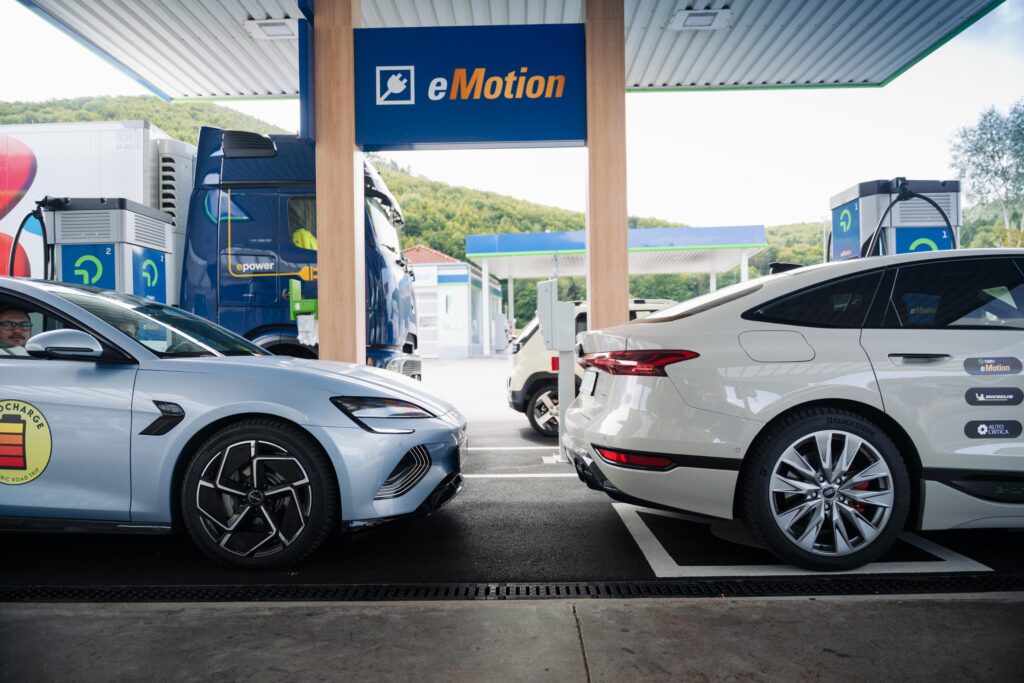
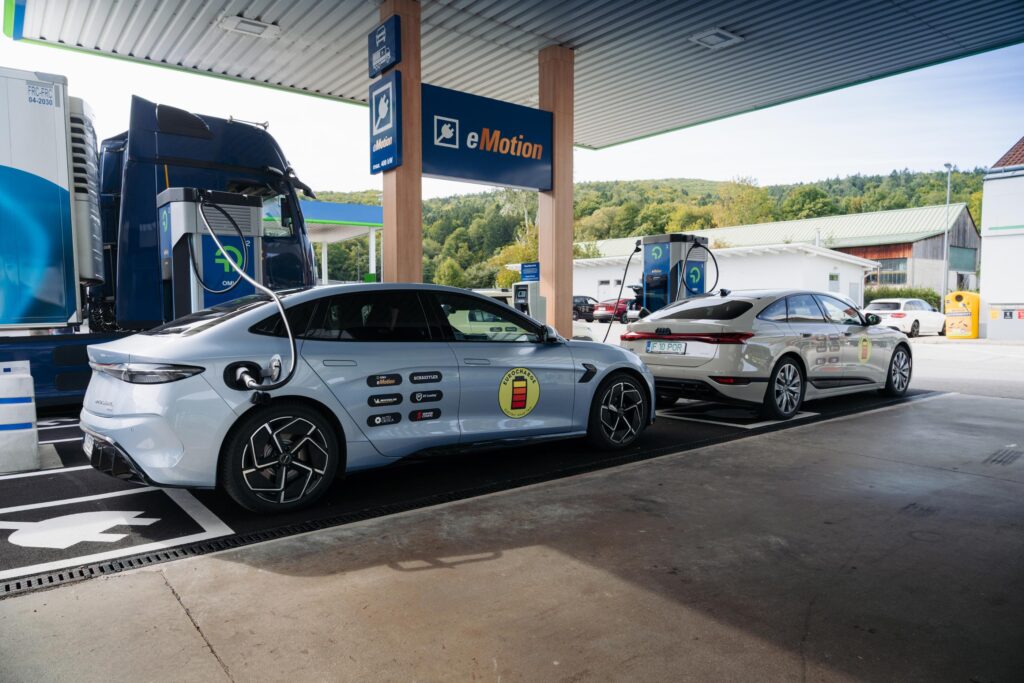
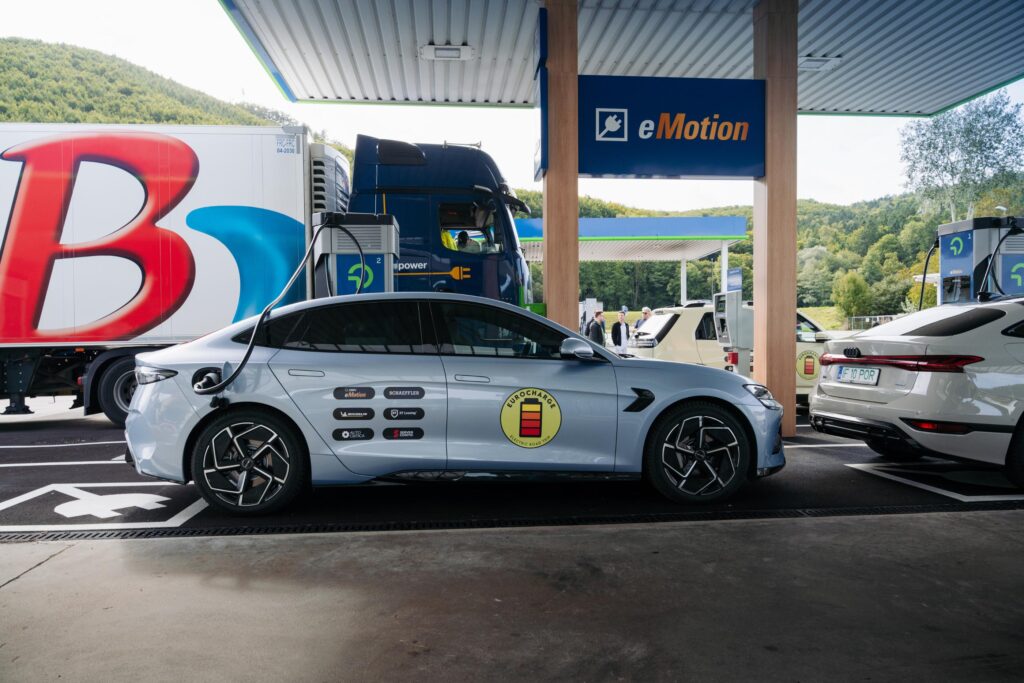
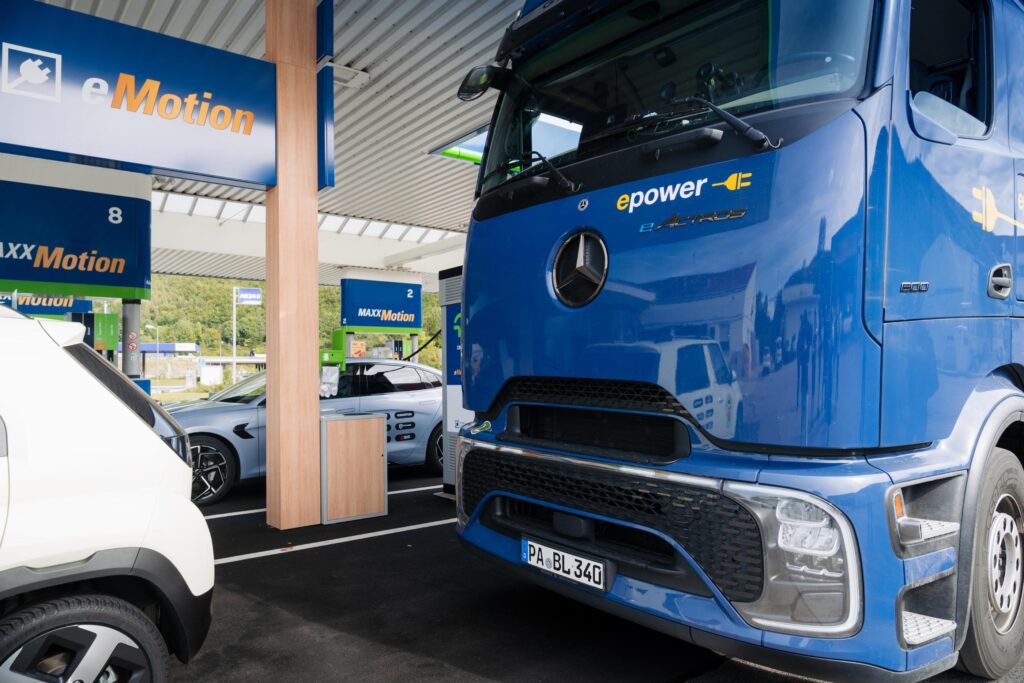
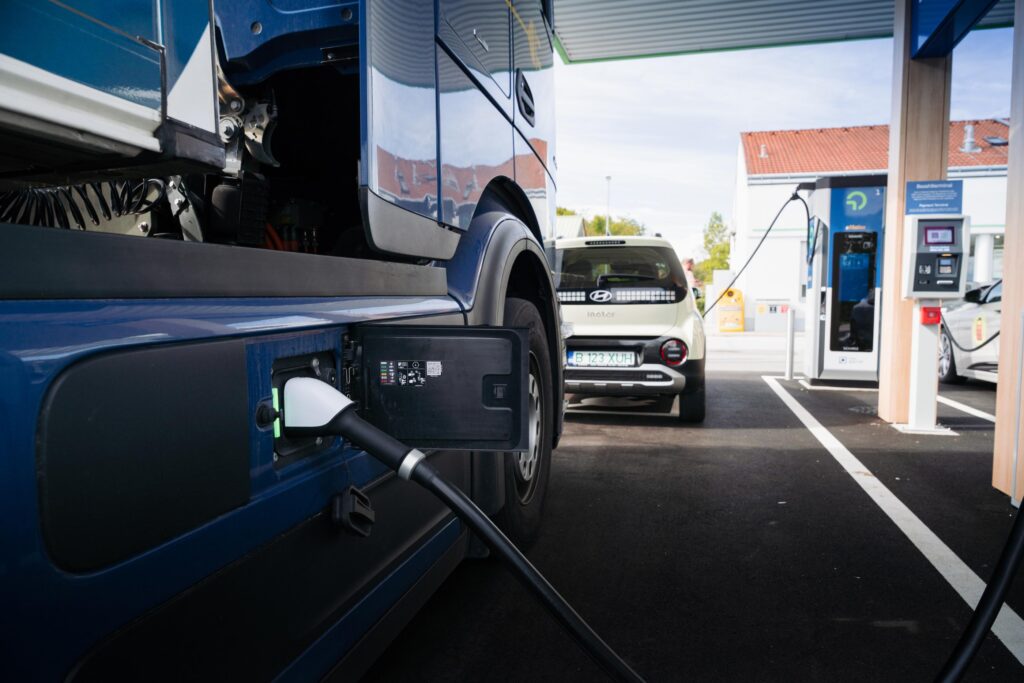
The Ultimate EV Hub
I left OMV Alland with the idea that I saw the future of charging stations under the same roof as fossil fuel stations, only to then end up at OMV Sankt Valentin, somewhere near Linz.
Here, electric cars get their own hub, separate from the gasoline/diesel hub, and the experience is of a premium status: eight stations packing 300 kW and 400 kW charging capacities, plus three dedicated charging stations for trucks. In total, 16 charging points for electric cars and six for electric trucks. Basically, the eight EVs in the EUROCHARGE caravan were able to charge simultaneously here and occupy only half of the available designated places.
In addition, the entire EV-dedicated area is covered with photovoltaic panels, which reinforces the electric mobility efforts behind OMV’s strategy by producing its own carbon-free electricity.

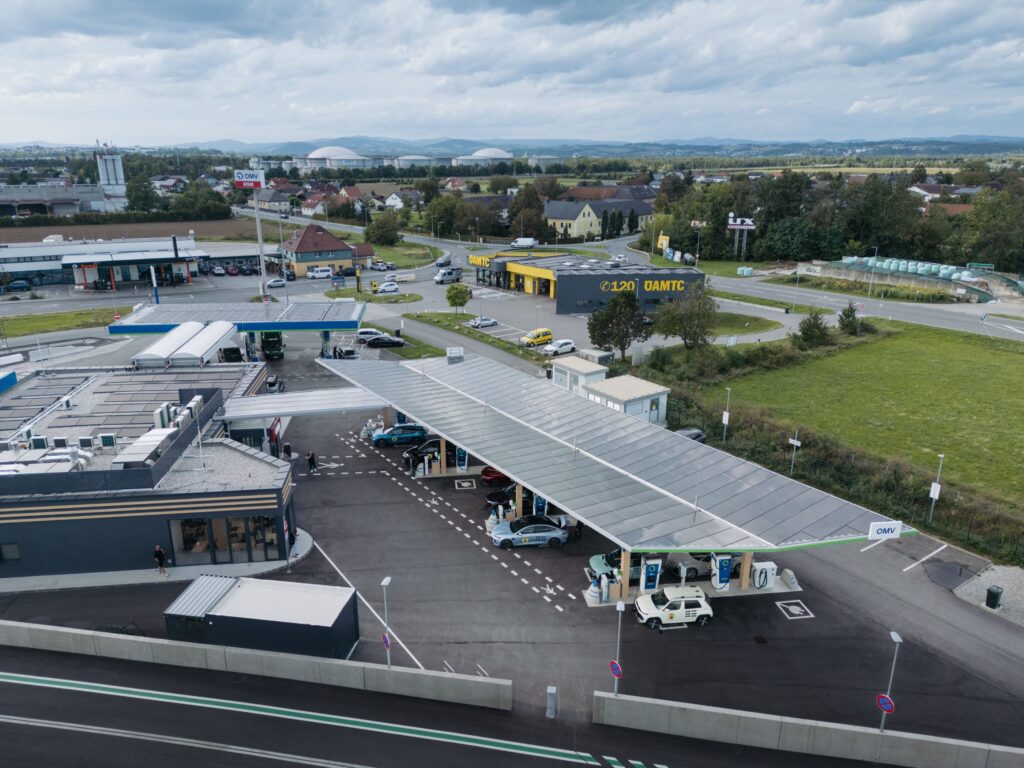

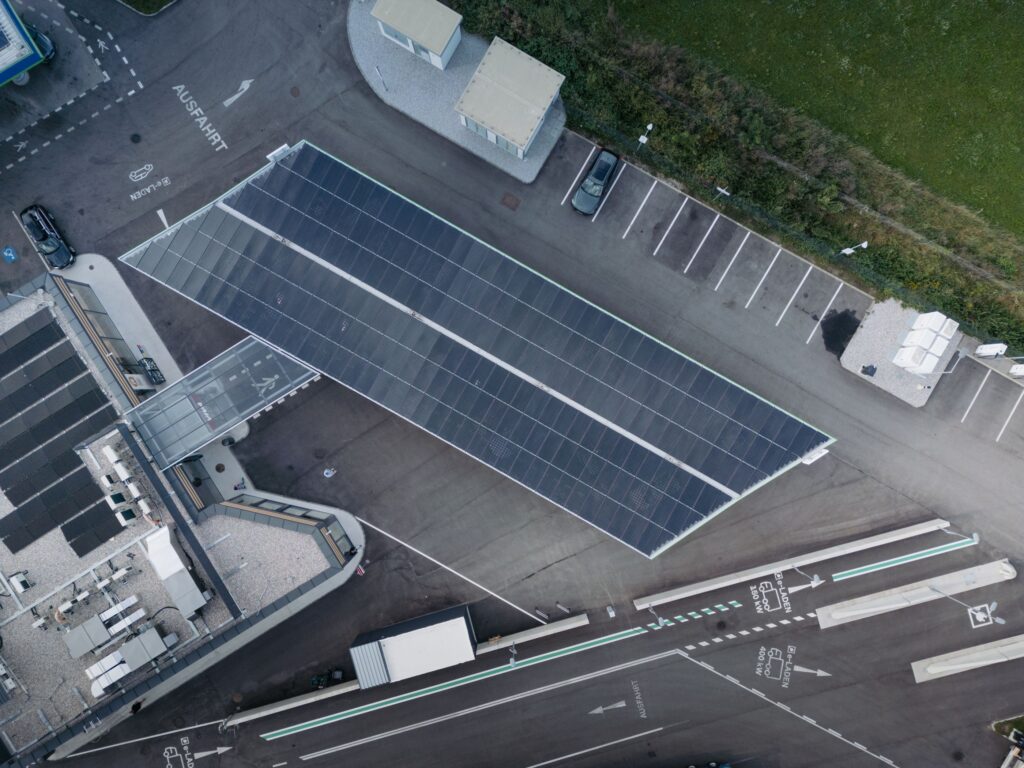
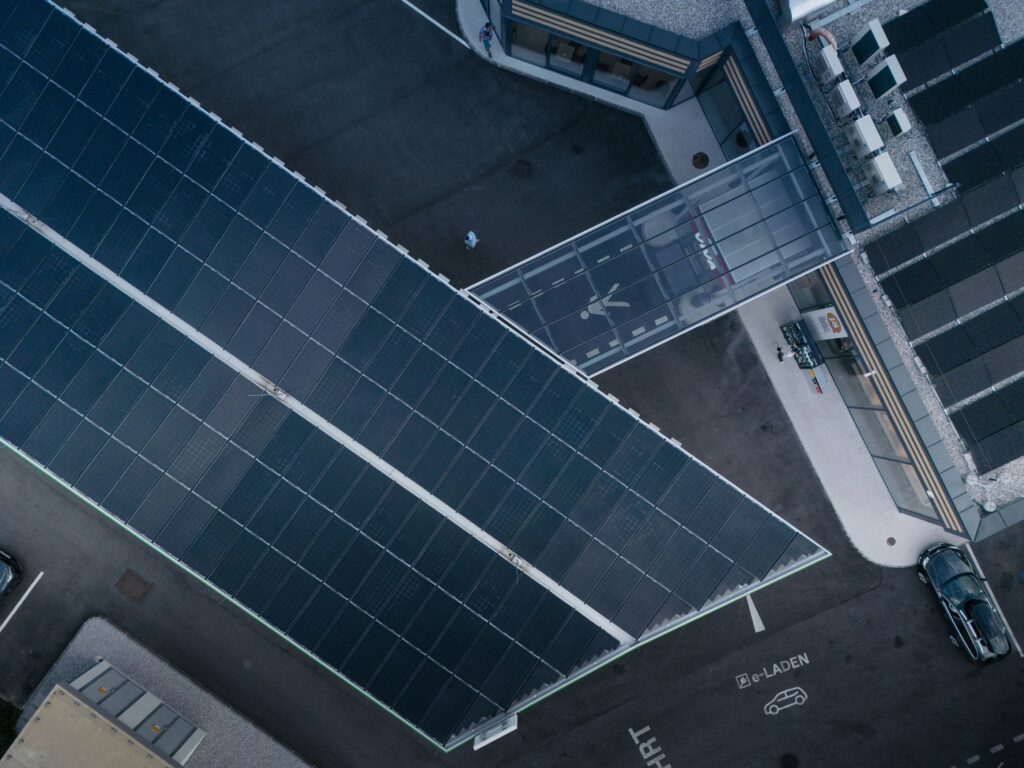
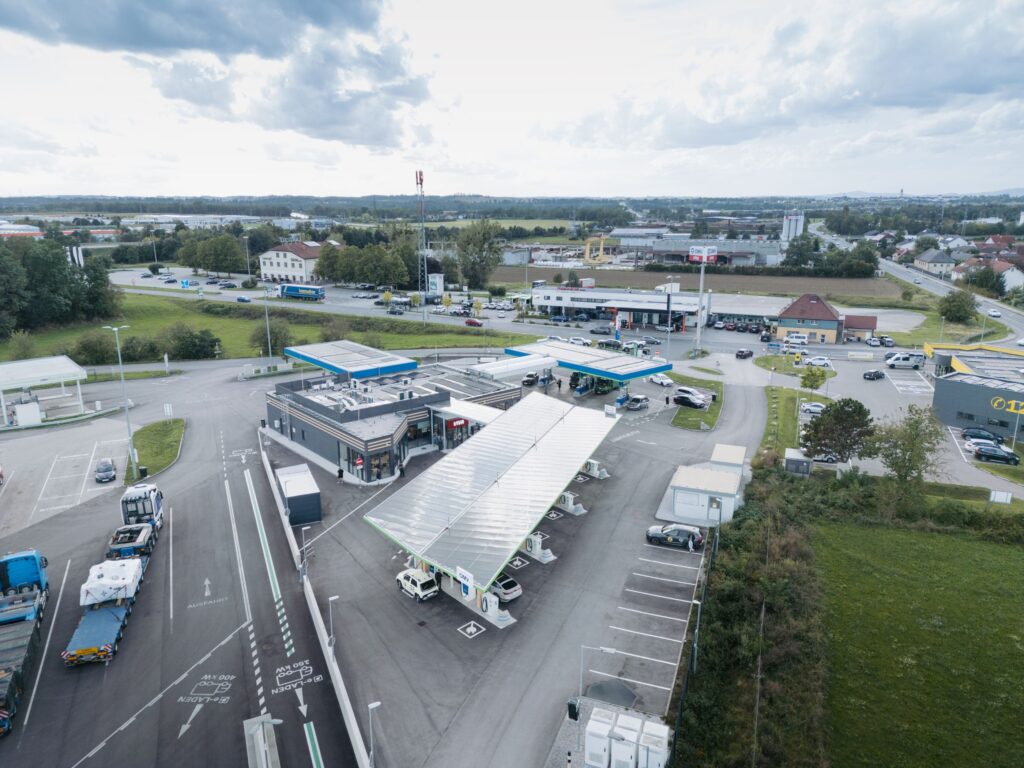
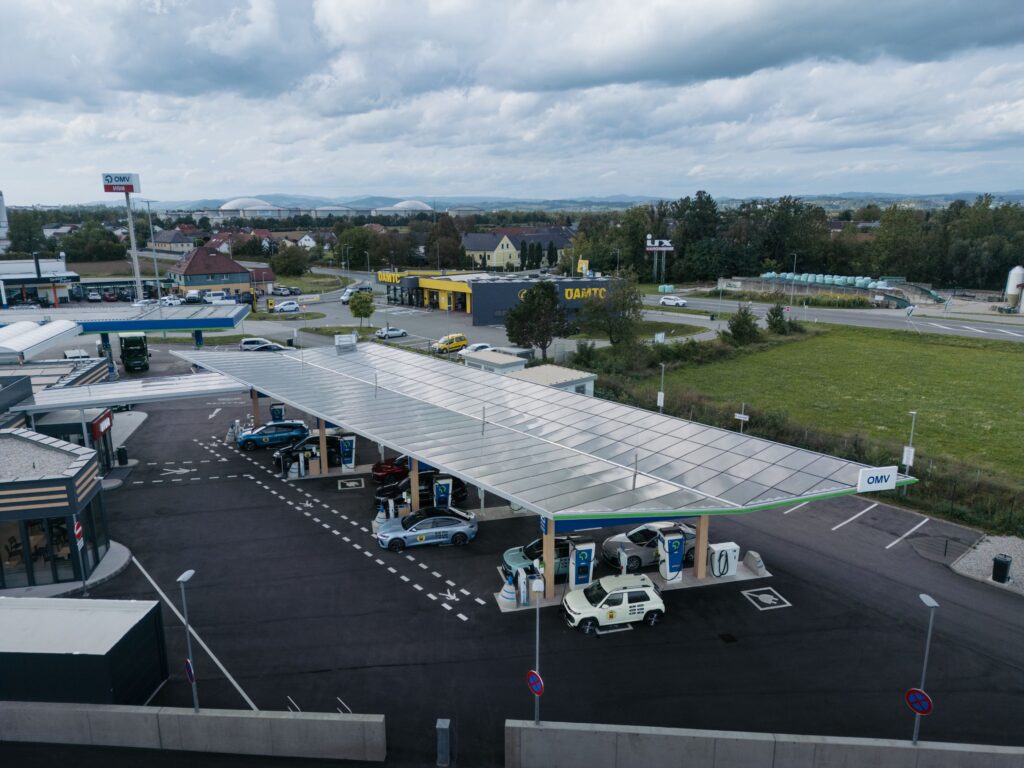

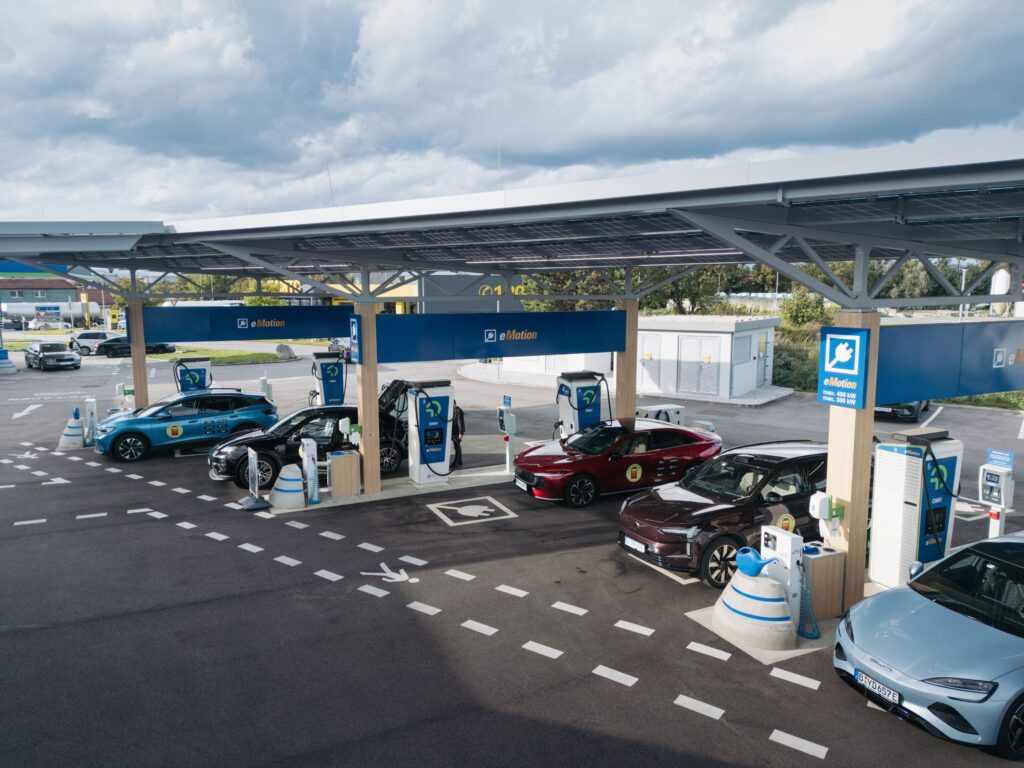
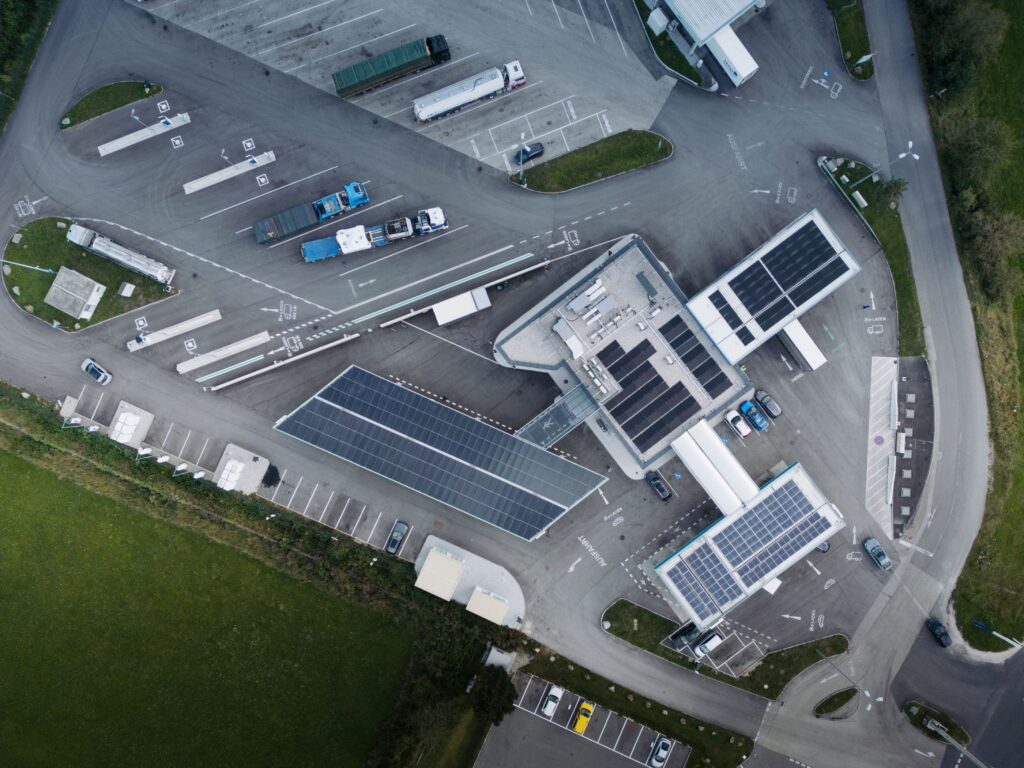
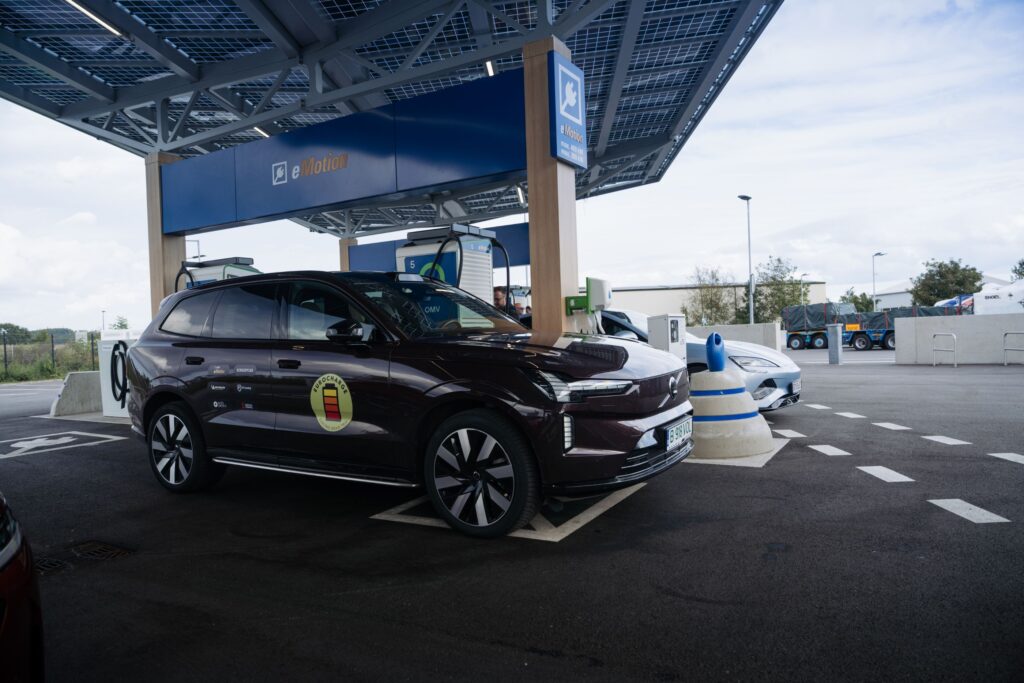
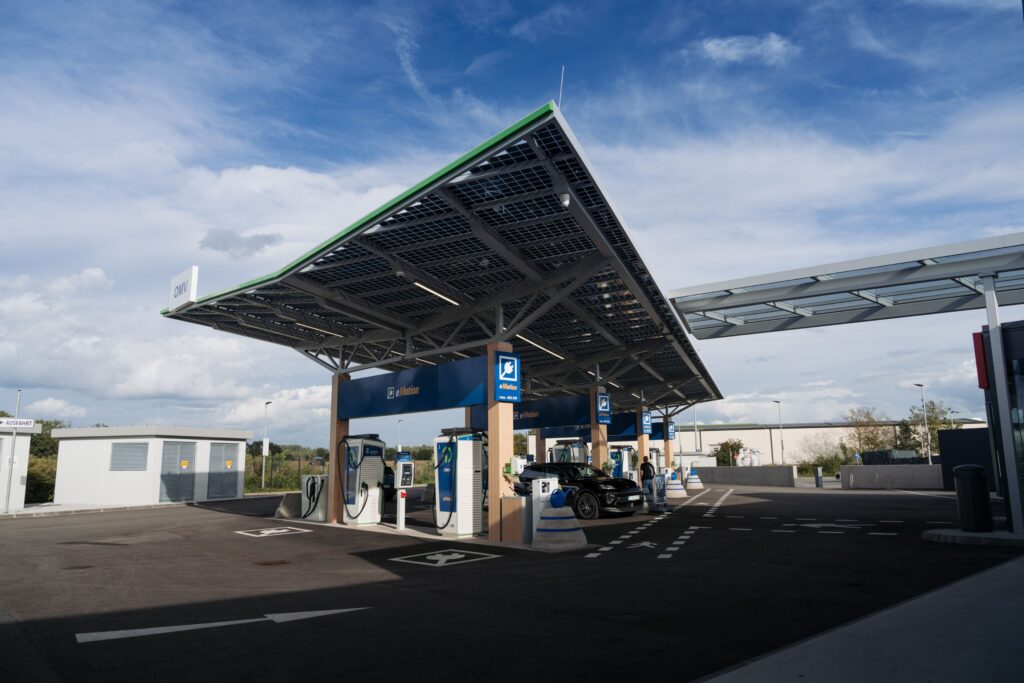

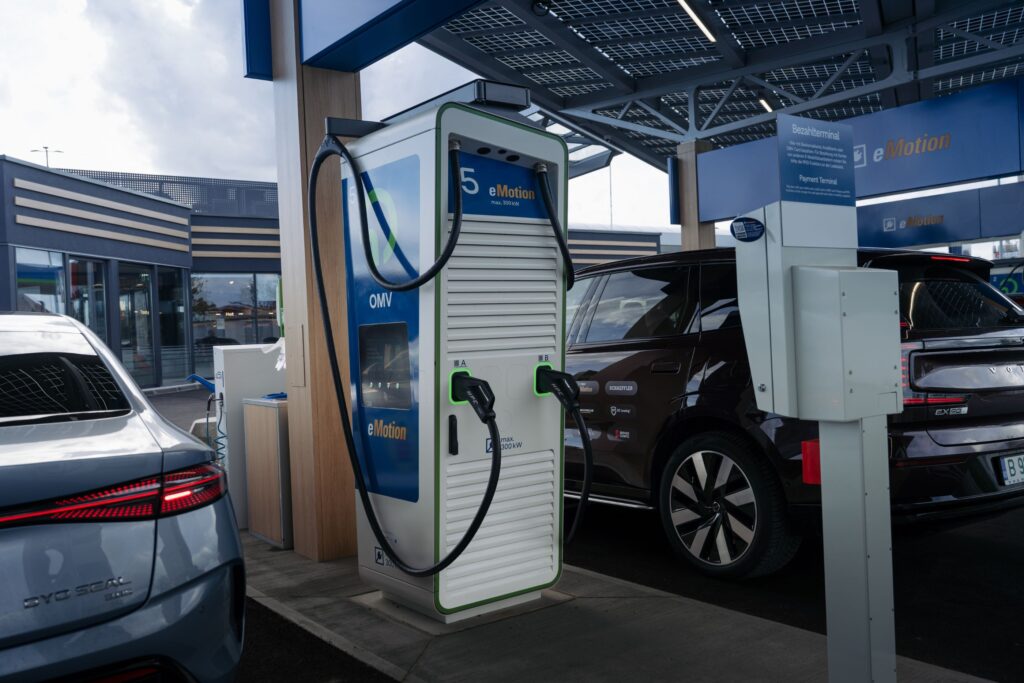
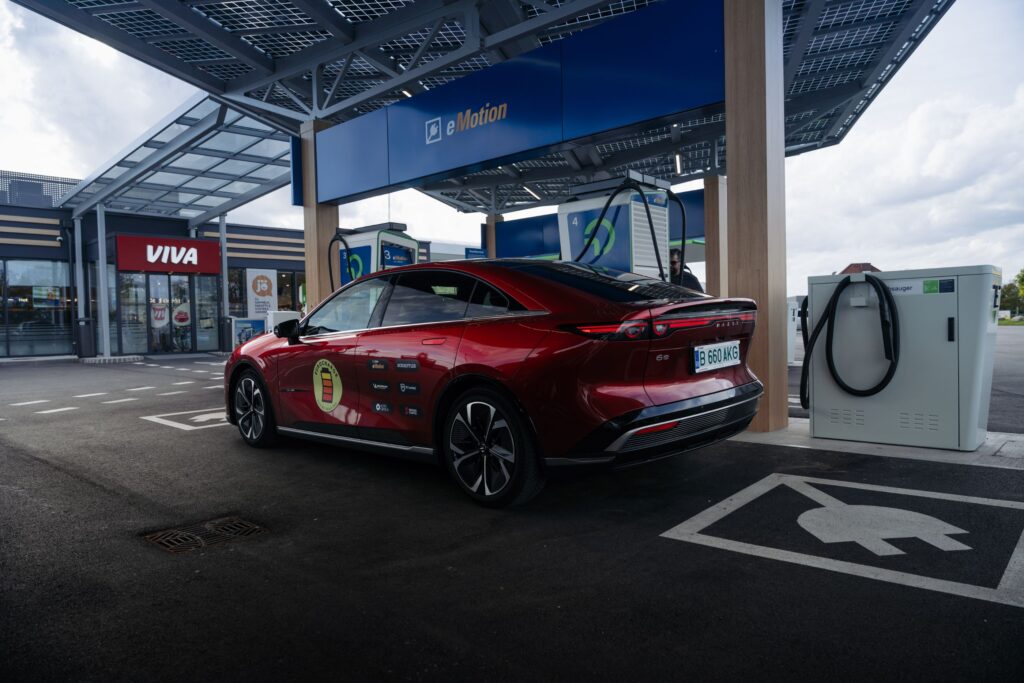
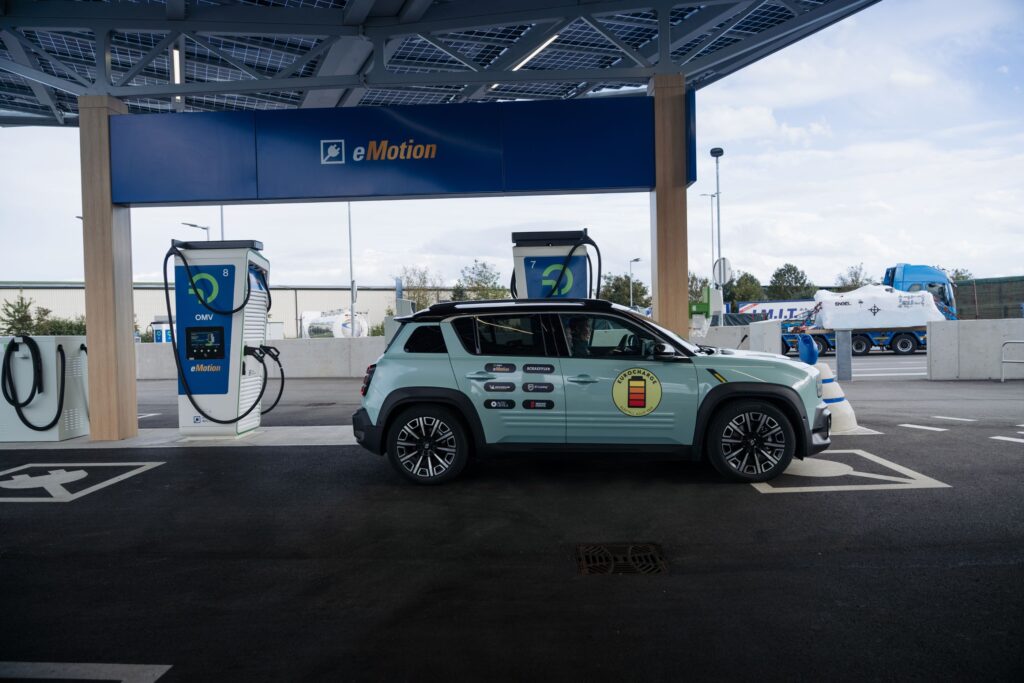

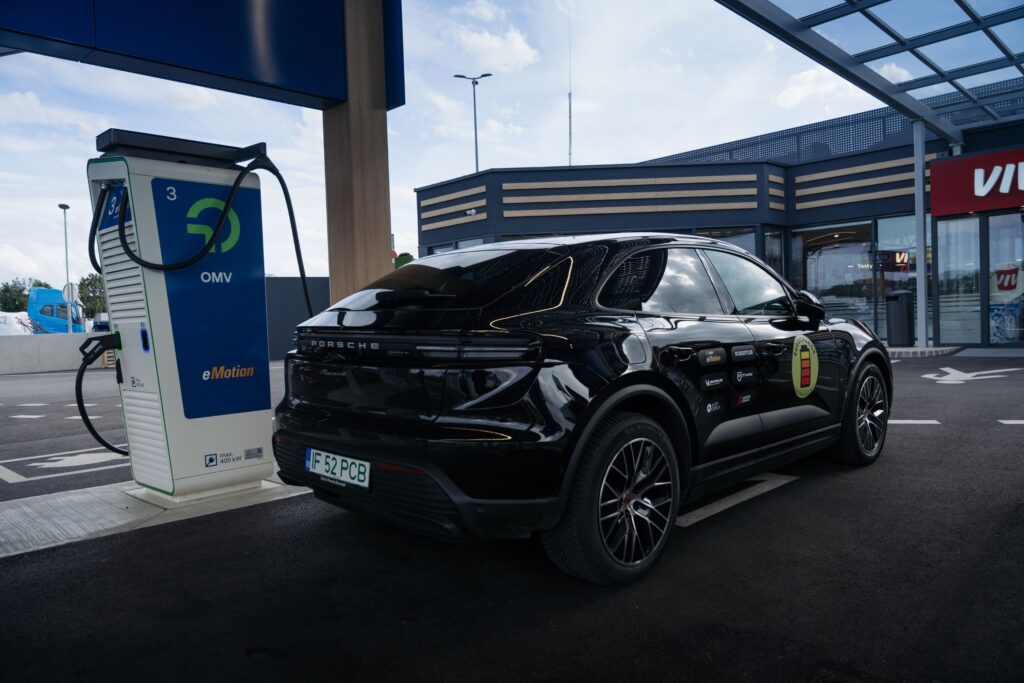
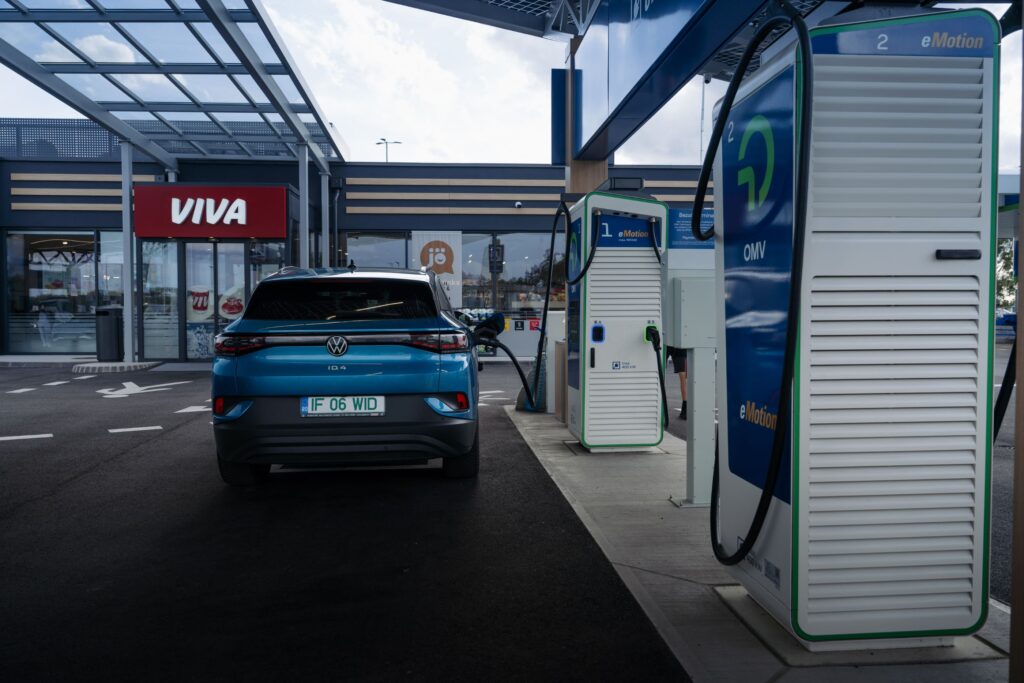
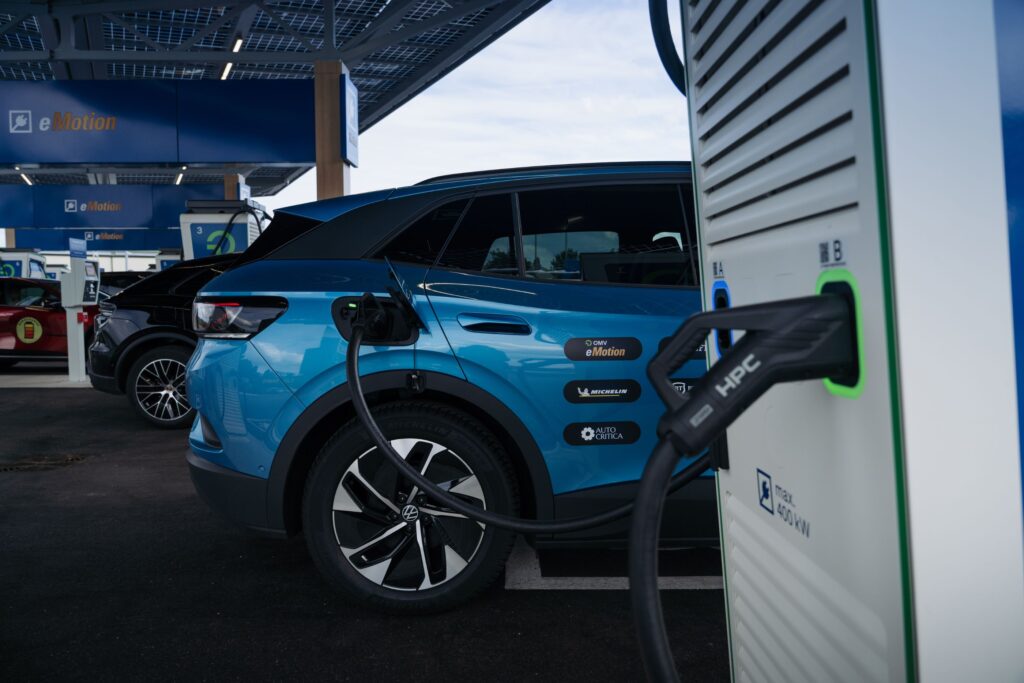
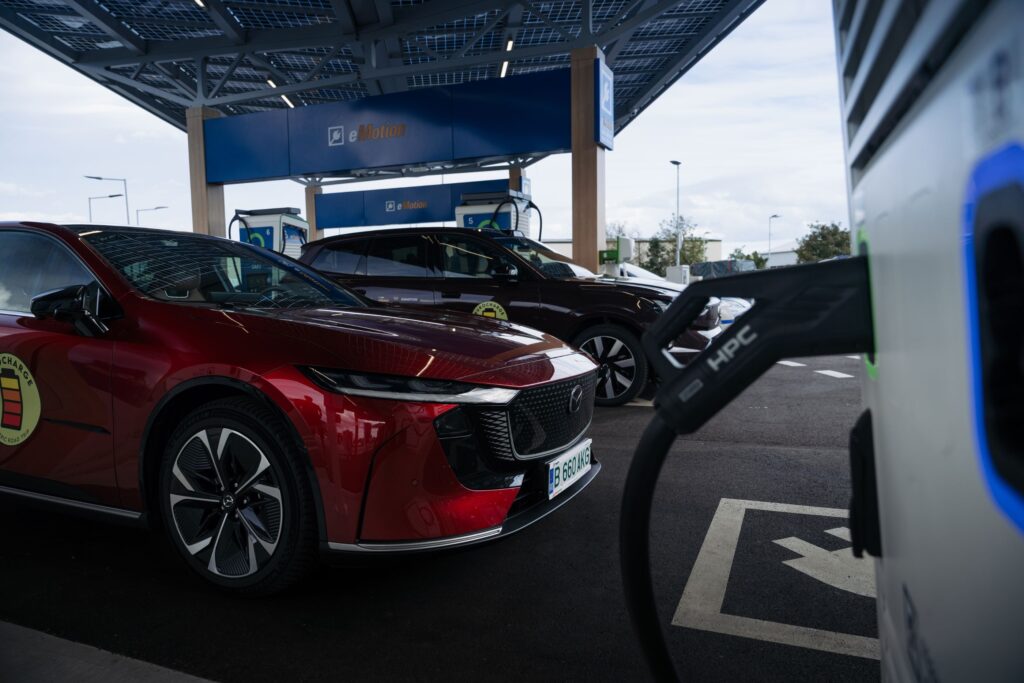
And last but not least, it’s all about customer convenience: this photovoltaic panel system is also a form of protection for customers during periods of bad weather. Especially since you can enjoy the many VIVA culinary delights and an espresso to keep you energized while charging.


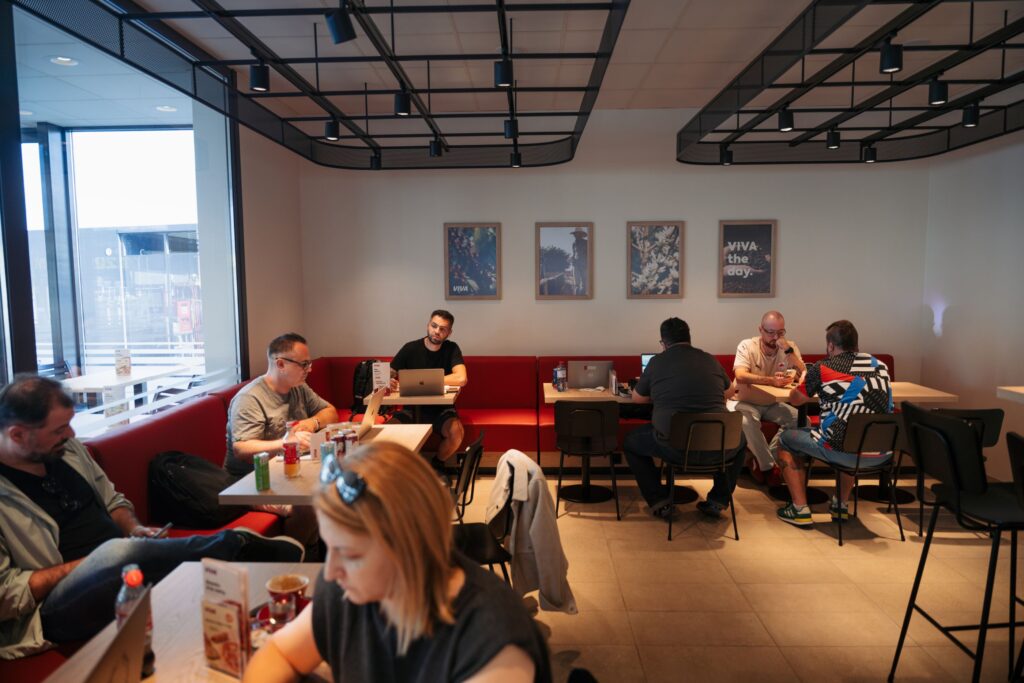

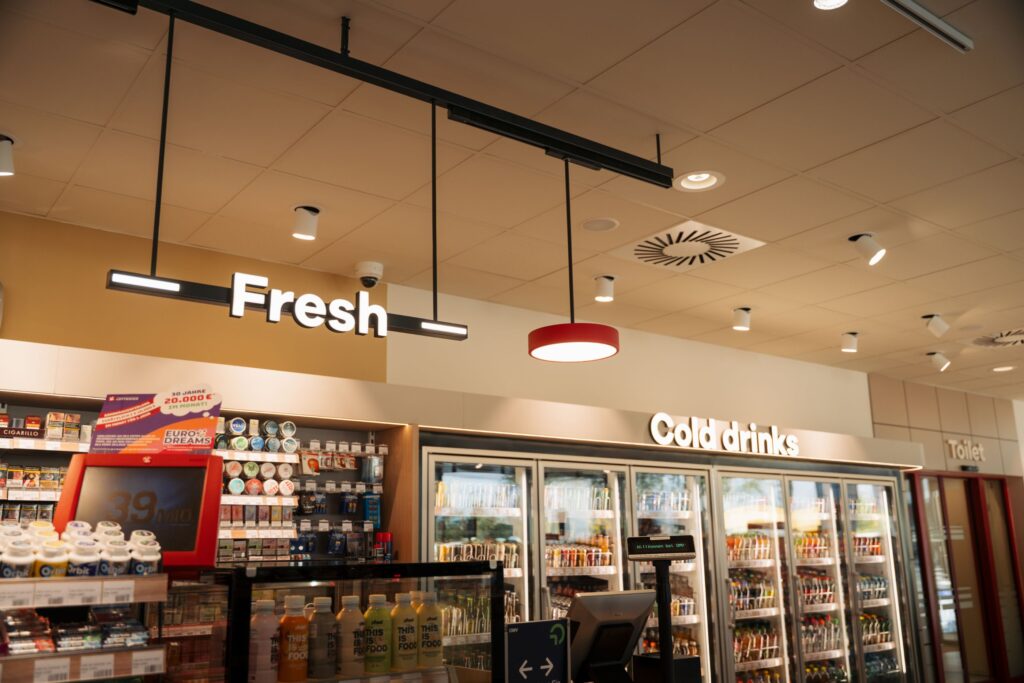

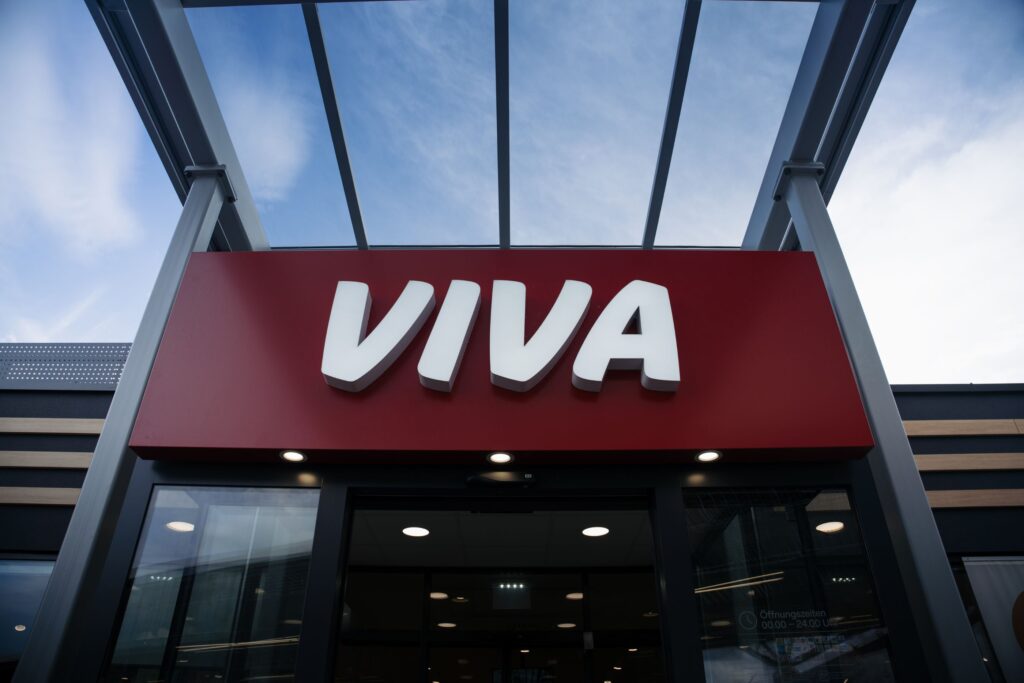
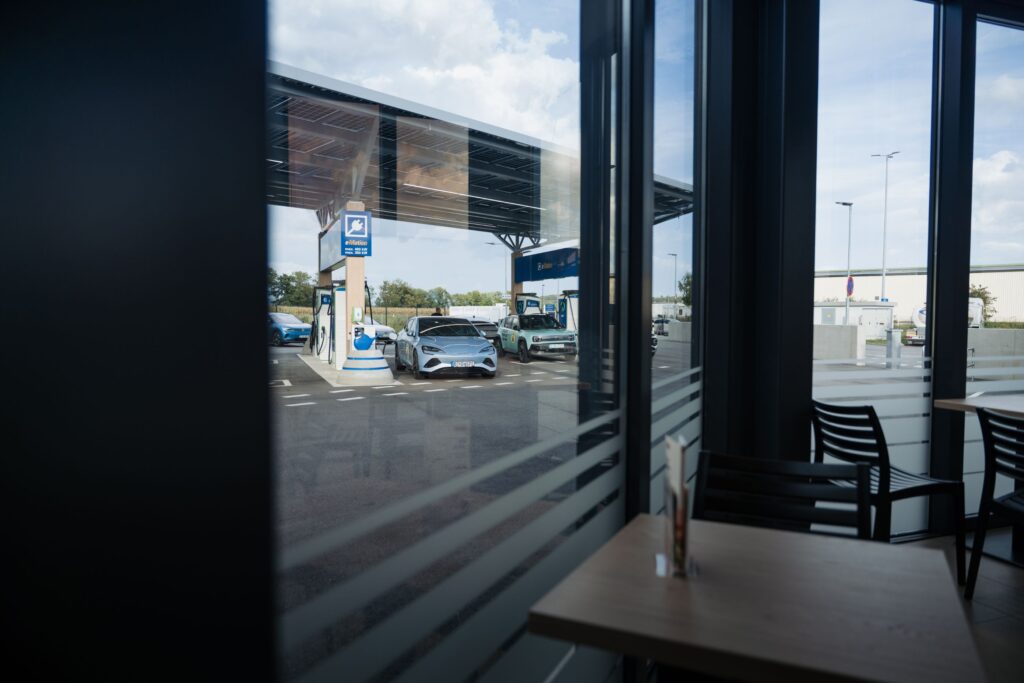
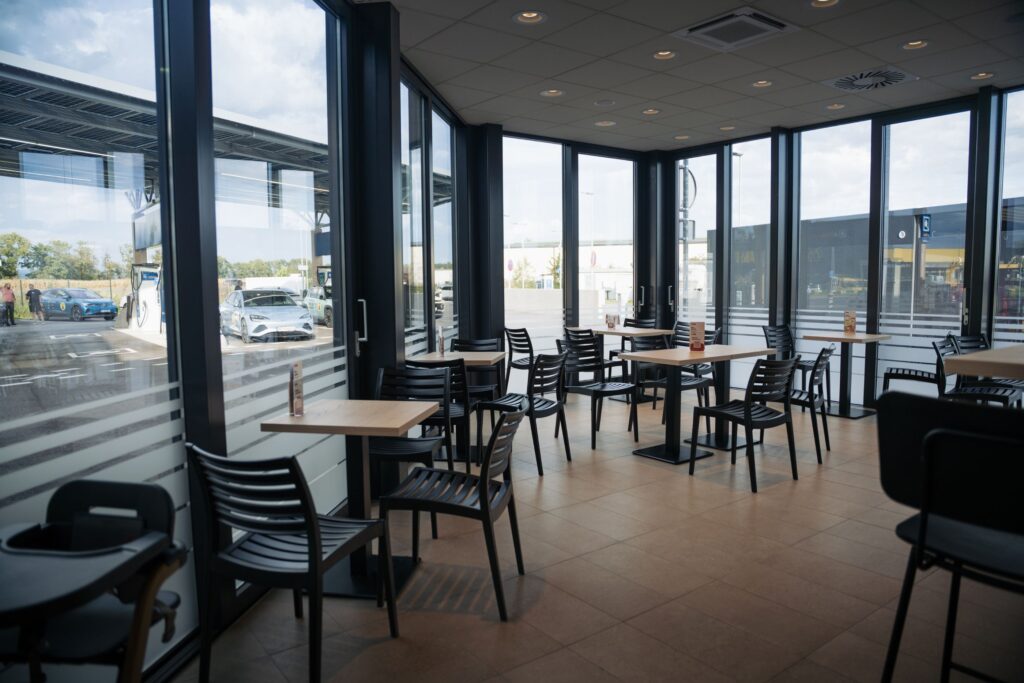
After seeing two concrete examples of what the EV charging infrastructure might look like in the future, we finally arrived in Saalbach, our headquarters for the following two days.
In Saalbach we set up our headquarters for the next 3 nights and, after a day’s necessary break to recharge our own batteries, we will finally get to where we set out from the start: the Alpine passes. In the meantime, here are the road trip colleagues’ impressions of the cars they drove in Hungary and Austria.
Laura Antonov (LaChicBoutique) on the Audi A6 Sportback e-tron
After just a few kilometers, the Audi A6 Sportback e-tron will make you kind of want an electric car (and be rich, obviously). And that’s because it’s extremely efficient. So efficient that it can get annoying when you’d like to stretch your legs out over a cappuccino. It’s very efficient and charges quickly, the winning combination for an electric car. It’s like when you find your favorite sweater on sale and winter’s just started, so you can still wear it for a long time.
As a passenger, I liked the display where I could change the music if I didn’t like my traveling companion’s tastes, and even fiddle with the navigation setup.
From the driver’s seat, there’s not much to complain about. I felt so spoiled behind the wheel that it raised the bar very high for the next car I drive. It maintains the optimal distance from the car in front, keeps you in the center of the lane without having to move a finger, decelerates on its own when it detects an obstacle or a vehicle in front, and when you signal to overtake, it does that almost on its own so you don’t get too much fatigue behind the wheel.
Basically, the about 350 kilometers really flew by and by the time I got to the hotel, I felt like after a spa trip with the girls.
The A6 Sportback e-tron is the perfect car for a road trip through Europe. And not just because it’s roomy and has an extremely generous trunk, but because it gives you that positive, laidback vibe, like a concierge going out of their way to fulfill your every wish. So there’s not much that can go wrong on your vacation. Unless, that is, you don’t know where you’re going to get more than 100,000 euro for your Audi A6 Sportback e-tron.
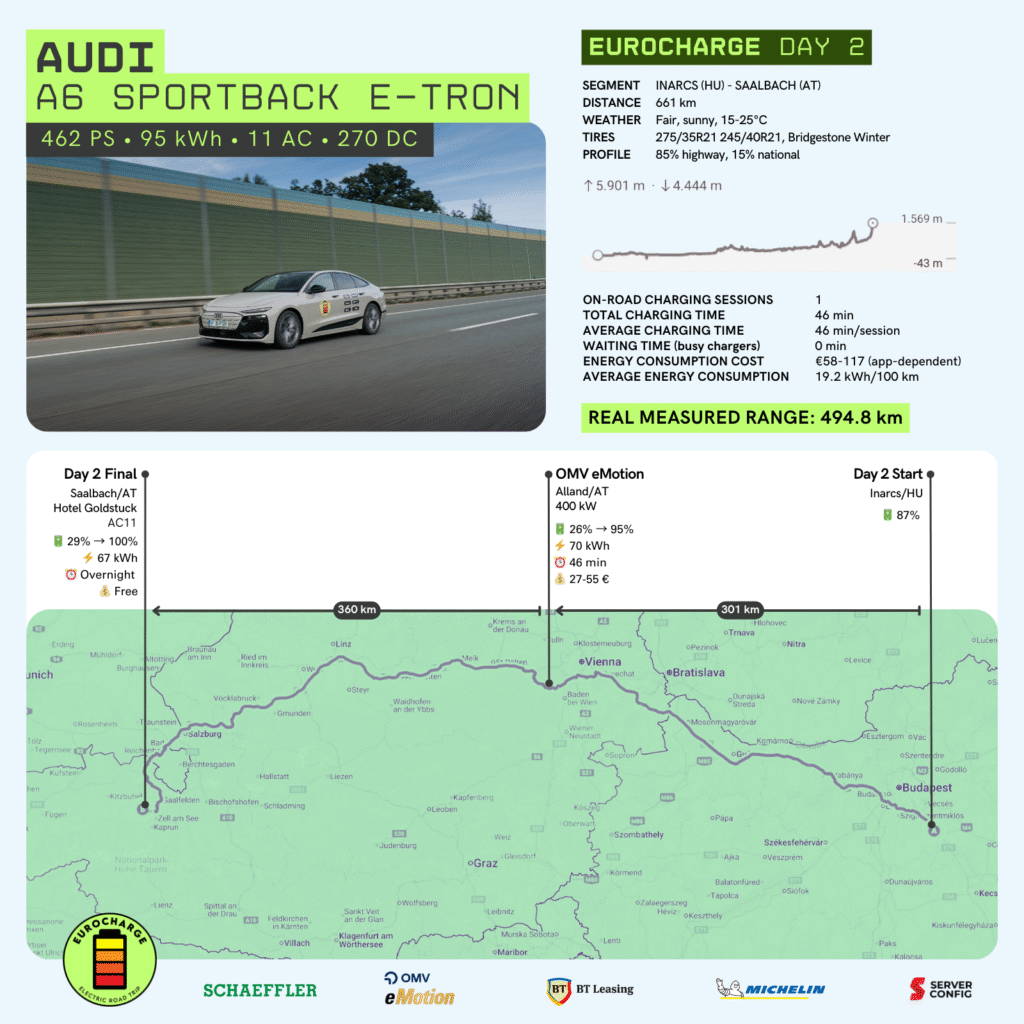
Adrian Mitrea (0-100.ro) on the BYD Seal
BYD Seal is the third model of the ambitious Chinese brand that I drive, after Sealion and Dolphin Surf. And the Seal reconfirms my first impressions of BYD: solidly built, mechanically robust, well put together. And the BYD Seal was a pleasure to drive. More than other BYD models. The prerequisite for me to enjoy driving it was to disable most of the safety systems – their calibration has room for improvement as far as I’m concerned
Also, the level of attention to detail or material combinations left me wanting for more and lead me to believe that this is not the car that BYD will conquer Europe with – if it ever does.
In other words, the BYD Seal’s strong point is that it drives well, much like a Tesla Model 3. Mechanically, it’s just right.
Over the course of the day, it averaged 20.9 kWh/100 km, which corresponds to a real range of about 400 km in highway conditions. Which is not bad, but not good either.
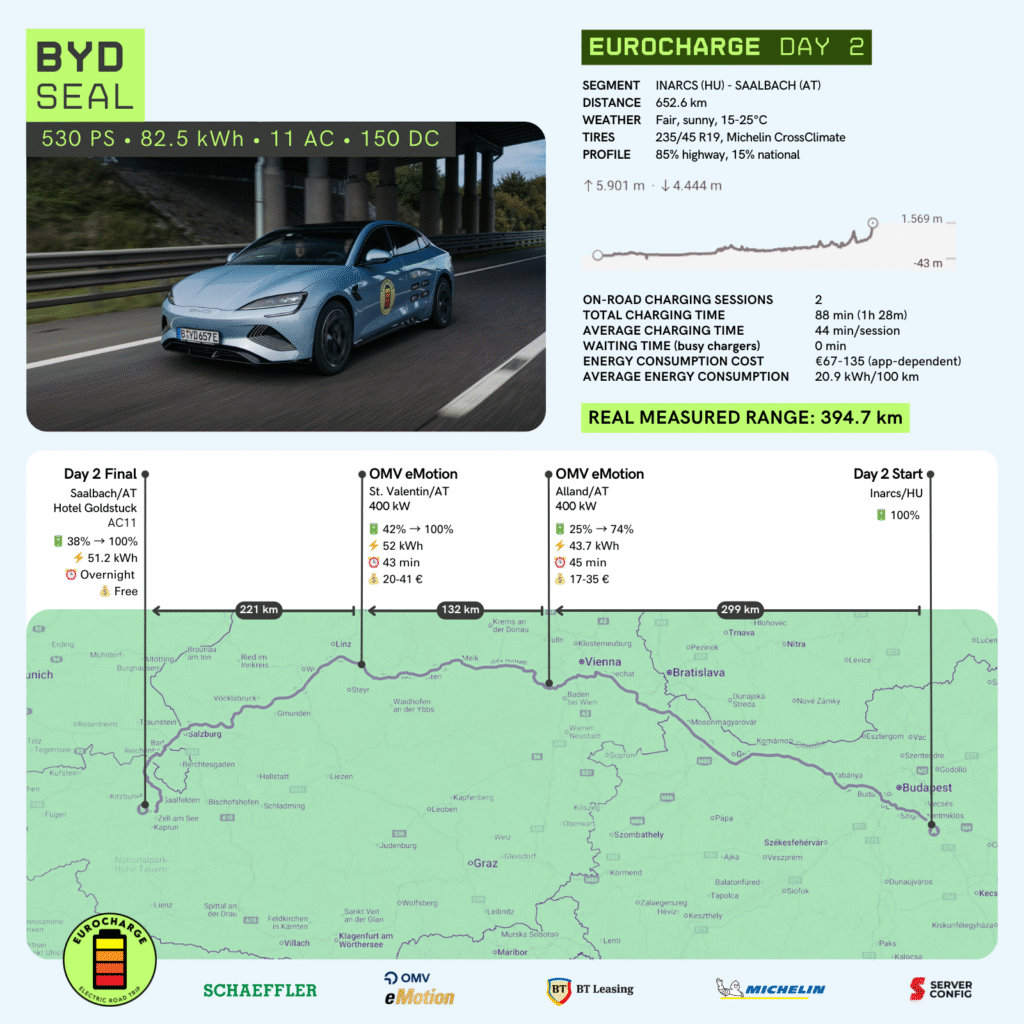
Dan Scarlat (Top Gear Romania) on the Hyundai Inster
As it’s customary in the automotive industry, Hyundai has also set out to answer the question: what is the optimal balance between form and function? And, with the help of the Inster, it has succeeded quite convincingly.
I can’t say a bad word about design. Frankly, as subjective as this topic may be, you can’t help but appreciate the effort. You may not necessarily be a fan of curvy shapes on absolutely any body panel, but you couldn’t say that the Inster is in any way boring, either. It has a big toy attitude and most importanty, all the styling details work very well together.
As for function, well, despite its small size, this little car proves incredibly practical. Interior space is utilized to the maximum: the bench seat slides back and forth, the front seat backs can be folded down to create a sleeping area, and there’s generally enough room for four adults to travel comfortably – at least if they don’t take too much luggage with them.
There were only two of us and, with the seat folded down, we had no problem carrying my colleague’s wardrobe (he insists on calling it a trolley), but more importantly, after more than 600 km on the second day of Eurocharge, we arrived at the hotel without feeling drained of energy or with a stiff back. And the atmosphere on board greets you with that dose of playfulness you expect from a small car: bright colors, playful shapes, but surprisingly ergonomic.
You’d think it’s a big car, good enough to drive everywhere. But no, the Inster is an A-segment model, dedicated mainly to urban use and only rarely to out-of-town exploration. The fact that it’s a very small car also means extremely limited battery space. And the tall body, in which two 1.9-metre-tall passengers can wear hats, doesn’t go well with the idea of aerodynamics, and hence highway speeds.
No, the Inster isn’t noisy at 130 km/g, but it burns through its 46-kWh battery much faster there than it does squeezing through SUVs in the city. On the second day of the tour, the average energy constumption was 17.3 kWh/100 km, which in turn offers a real-life range of 266 km. So the smallest car on the tour isn’t exactly the best car for touring the Alps. But if asked, it’ll do that too.
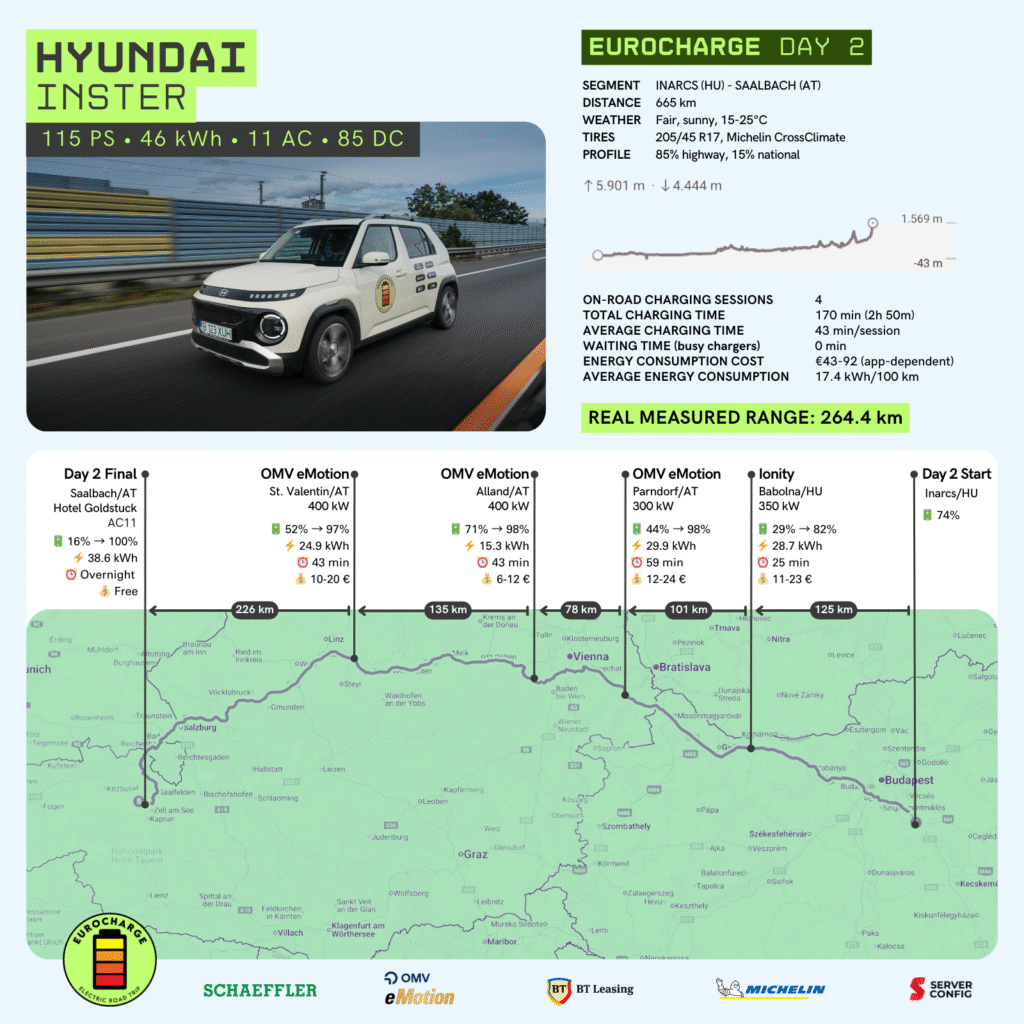
Price of the tested car: 25.585 euro with VAT
Through BT Leasing: 323 euro/month
Radu Gurămultă (Autocritica) on Mazda 6e
Honestly, I’m quite sorry to have come across the “new Mazda6” on the second day of the tour, because, I dare say, probably the most spectacular interior interaction of this project has already been sealed.
The new Mazda 6e not only has the most beautiful and well-thought-out interior in our group (sorry, Porsche, I betrayed you), but I dare to place it next to (and even above) models with much higher statuses – the likes of Audi A8, BMW 7 Series or Mercedes-Benz S-Class. I feel that many will probably not understand me, but I would like to be judged only after they see the model’s cabin in real life. Superior finishes, a symphony of Alcantara, a hi-fi audio system that really deserves its status (I wish I could convey in writing how imposing Mylene Farmer’s voice sounds inside the car), it seems to me that there was a strong desire to blow people away in terms of interior hospitality.
But it’s not all perfect. To top it all, I came across ergonomic oversights that I found annoying: the driving position, even adjusted to the deepest point, is far, far too high, and this makes it difficult for the driver to have a good view at the top of the field of vision. Then, the rear window is small, and the retractable rear spoiler will still cut into the available slice of rearward visibility. But the most annoying thing – though it seems like a great technological gimmick – is the transfer of essential controls from the analog world to the digital one; so, imagine navigating through the menus to adjust the side mirrors or use the wipers in a different way than when they start automatically. I swear I don’t understand why trivial and logical things need to be complicated.
Otherwise, I can see a lot of positives in the powertrain, even if I didn’t have the right context to take advantage of the solution adopted for the drive axle. I really liked the steering setup, even if its brilliance is overshadowed by the less chiseled interventions of the advanced assistance systems (i.e. the lane keeping assist). There’s room for optimization here. Elsewhere, the interior is quiet thanks to the excellent soundproofing, but above all the refinement of the drivetrain, together with the steering feedback, make any 6e ride like pure joy. They won’t hear this, but I’d really like to thank Mazda’s engineers who were involved in this project.

Constantin Ciobanu (Autocritica, Adevărul Auto) on the Porsche Macan
Slightly annoying this car here, because it does so much. And you, by virtue of some conditioning, set out to do some of that very much, but find that the machine has already taken care of it. Somewhere along the evolutionary chain, you feel it’s about time to hand over the baton, and enjoy the contemplation.
I’ll start the narrative about this Macan 4 from the last charge. A 400-kW OMV eMotion charging station. The moment the charge started was a challenge for the station’s display, the refresh rate barely managing to cover the sprint to 230 kW, which is how much the car managed to extract punctually from the station. Today, just two charges, one taking 18 minutes, the other 22 minutes.
I love it when a brand’s identity isn’t diluted by commercial winds. Even if the Macan is a family car, you can climb blindfolded inside and accurately tell you’re in a Porsche. The suspension settings, the ride feedback. And as difficult as it might be to drive blindfolded, the steering assists are the kind of details that provide that subcutaneous communication that lets you know who you’re dealing with.
But perhaps the most impressive detail is efficiency. As today was almost entirely dedicated to highway driving, to have an average fuel consumption in the region of 20 kWh/100 km while cruising constantly at 130 km/h, I find that impressive. I’m not talking about dynamic performance – whic his right up there to the level Porsche likes to deliver. The only challenge is to get past the perhaps slightly cold air of the interior, to let it convince you, to discover the elegance that comes from decades of soberness.
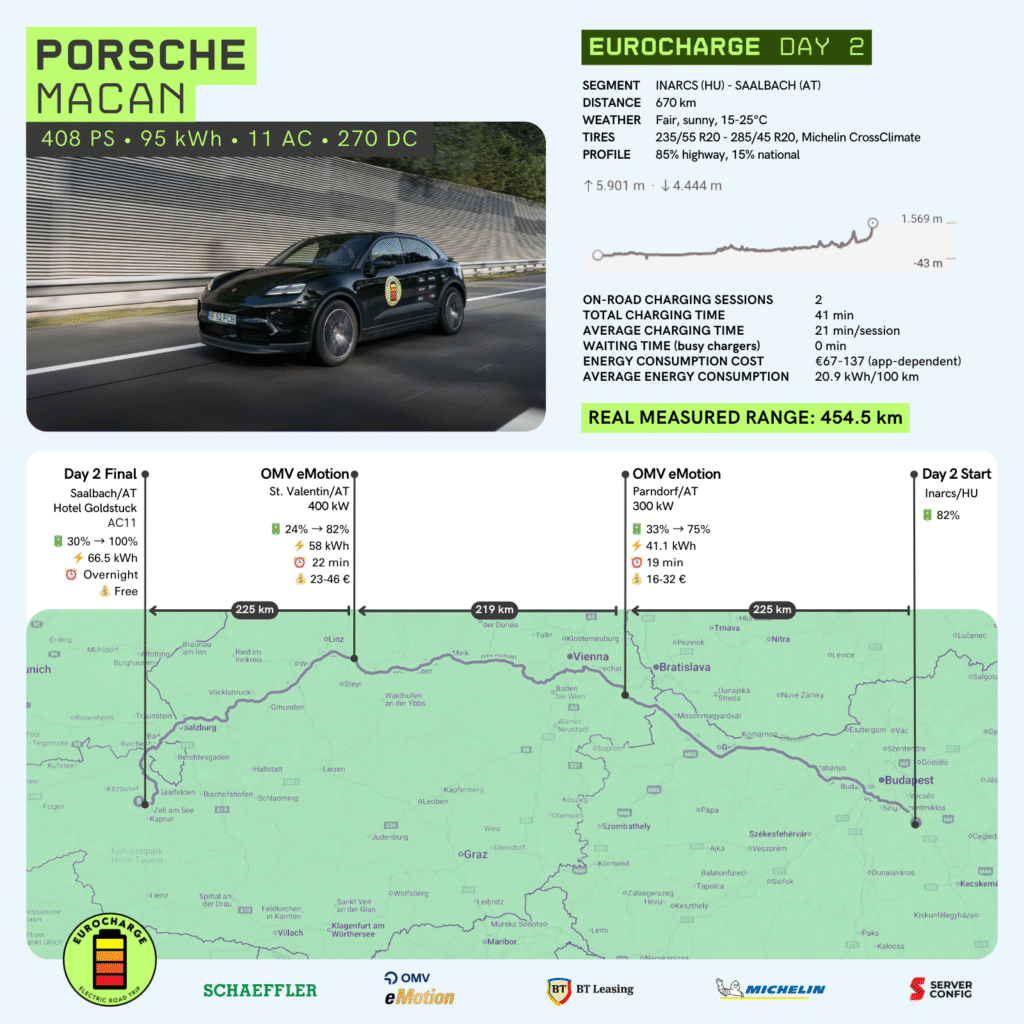
Mihai Vasilescu (Digital Storyteller) on the Renault 4 E-Tech Electric
I have an almost complete collection of Renault miniatures at home, miniature models of almost all the cars Renault has produced over the years, including the new ones. Why do I say “almost” all the models? Because I’m missing a few, including a miniature Renault 4. And not because I didn’t want to buy it, but because it was effectively out of stock. And there’s only one explanation: these cars are so beautiful both in full size and in miniature, that you can’t refrain from buying them.
The idea of the French to bring back a famous, iconic model I might say, was absolutely sensational, I wanted to drive it since the day it was launched, but lo and behold, I didn’t. Until yesterday, which was the day I met the Renault 4. I liked it in the official pictures and videos, but I had never seen it in real life. Now I can tell you that it looks just as good when you see it in the metal.
It’s so beautiful and graceful that you don’t even feel like touching it or getting in, afraid you might defile it. What’s even more interesting is that it’s just as retro-cute on the outside as it is on the inside, which is something that happens to cars quite rarely. In short, it’s one of the best retro designs ever. You immediately remember the old Renault 4 when you see it.
Looks aside, I really liked how agile it is. It’s nimble in traffic, you get into it, overtake effortlessly, it has a small turning radius, it’s compact, you don’t struggle on the road at all with it. It’s a pleasure to drive and it’s a pleasure to see people looking at it on the street. Because they do, you know.
Now a few details that will interest the electric-savvy. The 50-kWh battery is more than OK for a car in its class. As for consumption, after driving exclusively on the highway, I ended the day with an average consumption of 17.9 kW/100 km, which stands for a real range of 290 kilometers. I think that’s not bad at all, especially since the Renault 4 is neither marketed nor designed to be used as a car to go on thousands of kilometers, but as a city car, with which you can eventually take on vacation.
The only thing that made me wince was the maximum 100-kW battery charging power, but you probably don’t need more than that on a 50-kWh battery, either.
Last but not least, the thing that amazed me the most about the Renault 4: it has a huge trunk. Two large trolleys and two backpacks fit in just fine, something I didn’t expect at all.
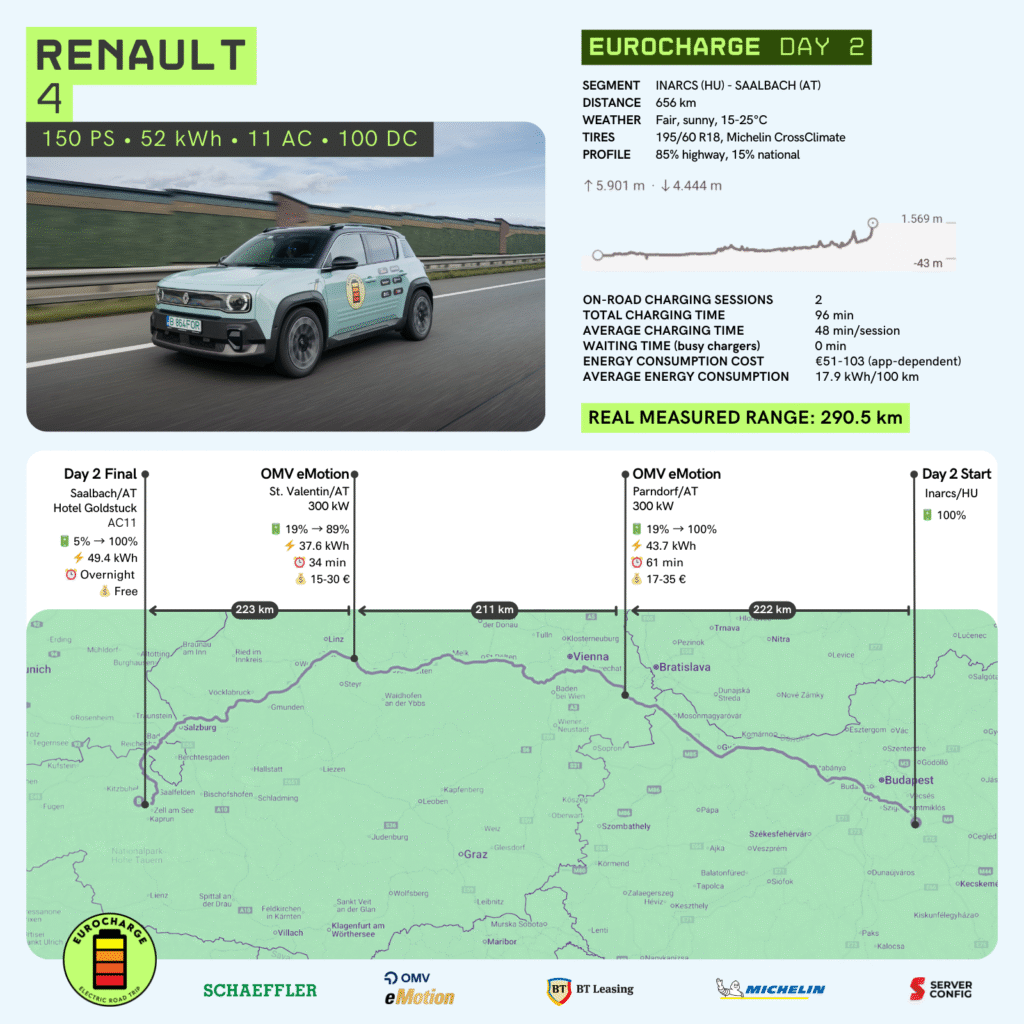
Cornel Șocariciu (Autocritica) on the Volkswagen ID.4
We’ve crossed paths a couple times now. Sometimes on shorter distances, sometimes on long and very long journeys. And even though it now comes in a technically upgraded version, the Volkswagen ID.4 is still the same reliable road companion. Simply put: it’s dependable.
Because that’s what ID.4 is. Dependable, trustwortky. No, I don’t think it excels in any major department, but it doesn’t struggle, either. It’s an all-rounder – a word coined specifically for cars coming out of Wolfsburg.
With this update coming in 2025, I found the ID.4 a bit more efficient. Even if it rides on a slightly outdated technical configuration (let’s be honest and admit that in the last four years there have been significant advances in the volume electric segment), the German crossover performs its duties with honor. The load curve is not to be neglected (you’ll see it in the infographic at the end), the range is not bad either, and the efficiency (aka energy consumption) was within good limits in the conditions we encountered today on the road (a highway in Hungary full of roadworks and 80 km/h speed limits plus similar situations in Austria).
Space, trunk volume, responsiveness, steering, regenerative braking and the infotainment system are all topics that the ID.4 passes with flying colors. Yes, I kind of wish I had the steering wheel with buttons instead of touch controls, I kind of wish I could see those dual controls for opening the windows disappear (today I fanned the back seats every time I wanted to open my window without rolling my eyes over the controls), and I kind of remembered that I like a classic armrest better. But those are minor quirks you can overlook or get used to.
I wouldn’t complain about the suspension, especially since the rear axle had to put up with quite a bit (two large bags, a cabin trolley, three backpacks, and some video equipment strapped through the trunk). On the other hand, the noise at highway speeds could be a few decibels softer.
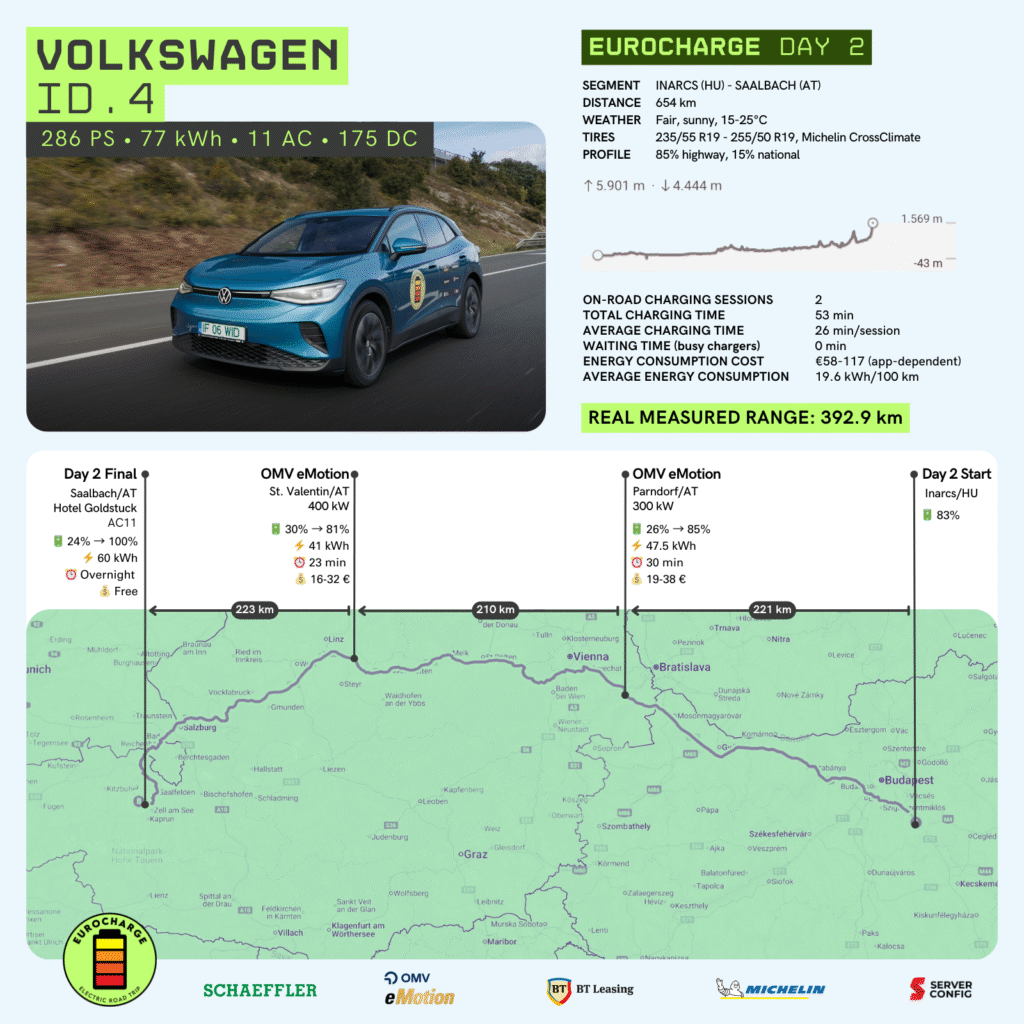
Andrei Nedelea (InsideEVs) on the Volvo EX90
Volvo wanted to transpose pretty much everything that made the XC90 a worldwide success for over twenty years into a new electric SUV when it created the EX90. And it largely succeeded. Although it looks like a slightly more futuristic XC90, the two models are not mechanically related. The EX90 is built on the SPA2 platform still found under the Polestar 3 and the forthcoming ES90, but Volvo has somehow managed to make the electric car convey much the same character as the equivalent ICE model only in an even quieter package.
I drove it almost 700 km today from Hungary to the Austrian Alps and it doesn’t feel like such a long drive. Our model has air suspension that makes any road feel smoother than it really is. And considering that the highways in the two countries are very good anyway, you practically feel like you’re floating and see the color of the asphalt change from time to time. But that’s about it.
The suspension has impressed me the most on the EX90 and I find it to be one of the best air suspensions I’ve had the opportunity to test in recent years. It’s even ahead of its XC90 sibling in this respect, helped by the more sophisticated air cushions, the slightly longer wheelbase and higher mass (just over 2.8 tons) combined with a lower center of gravity given by the 107-kWh battery pack it carries in its belly.
It controls its mass well, though, and doesn’t lean too alarmingly in corners. There’s plenty of power in the top twin-engined, 517 HP variant. Peak torque of 910 Nm simply catapults the EX90 towards the horizon with the verve of a smaller, lighter vehicle and makes you feel quite invincible when driving it. Knowing that it’s a Volvo that puts extra premium on safety makes the feeling even more obvious.
Considering the EX90’s mass and power, the end-of-day consumption of 25 kWh/100 km is quite reasonable. What surprised me is that even after the highway segments where we caught a lot of road works and had to abide by 80 km/h or even 60 km/h speed limits in some places for quite long distances, the average consumption never dropped below 24 kWh/100 km.
Although I generally prefer lower, lighter, sportier cars – I’m very curious about the Audi A6 e-tron and Mazda 6e on this tour – I understand the attraction to a big Volvo SUV feeding on electrons and almost want one now. What surprised me was that although we only charged it from stations that could deliver at least 300 kW, our EX90 didn’t draw more than 143 kW, although we also charged it from 37% with an ambient temperature (theoretically) almost ideal to see it approaching its maximum charging output of 250 kW.
And frankly, on today’s stretch of B-roads, I felt it a bit more incisive. Or was it the monotony of those 500 kilometers spent on the highway?
